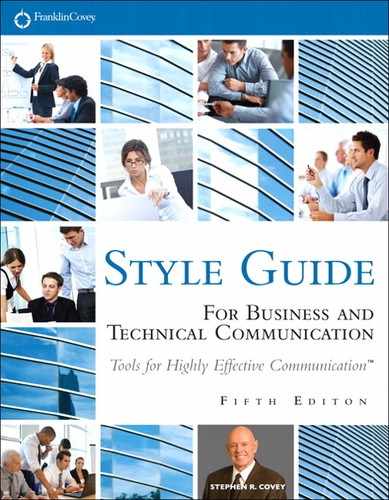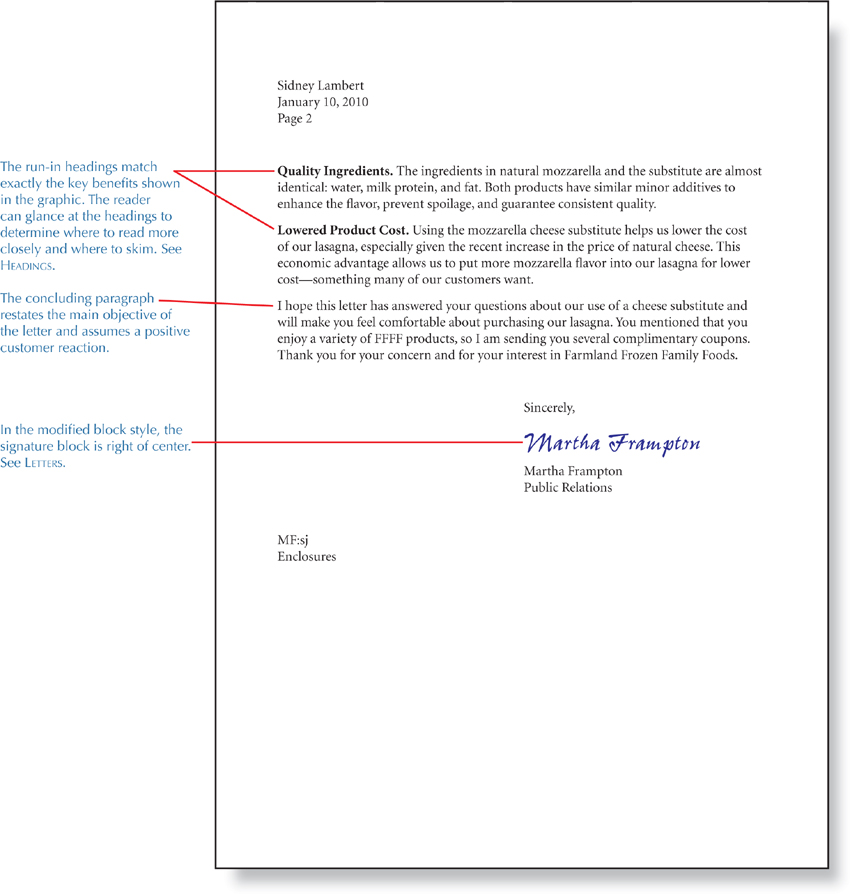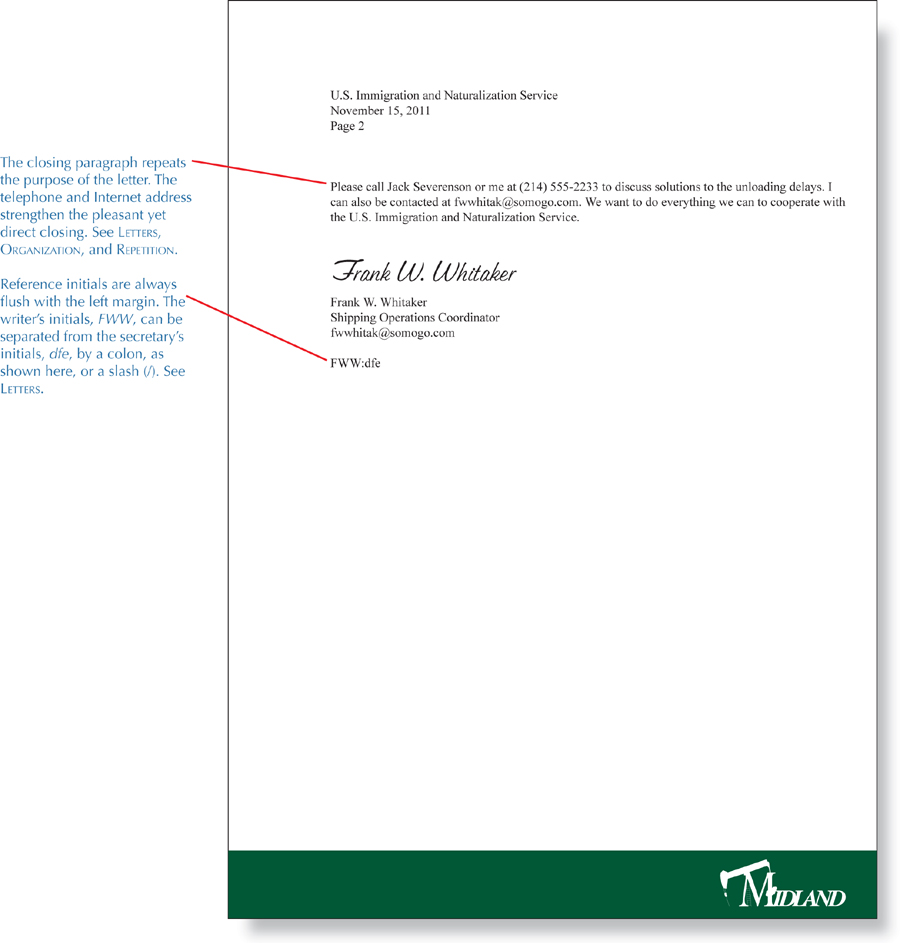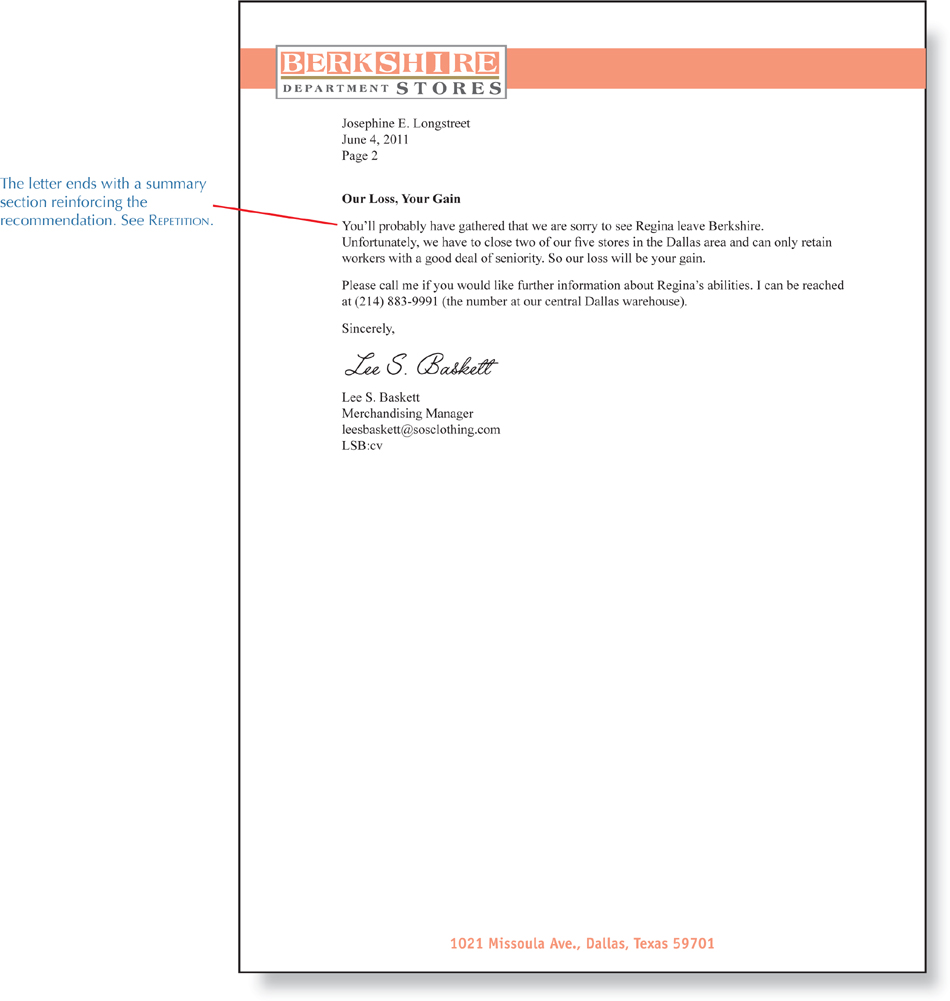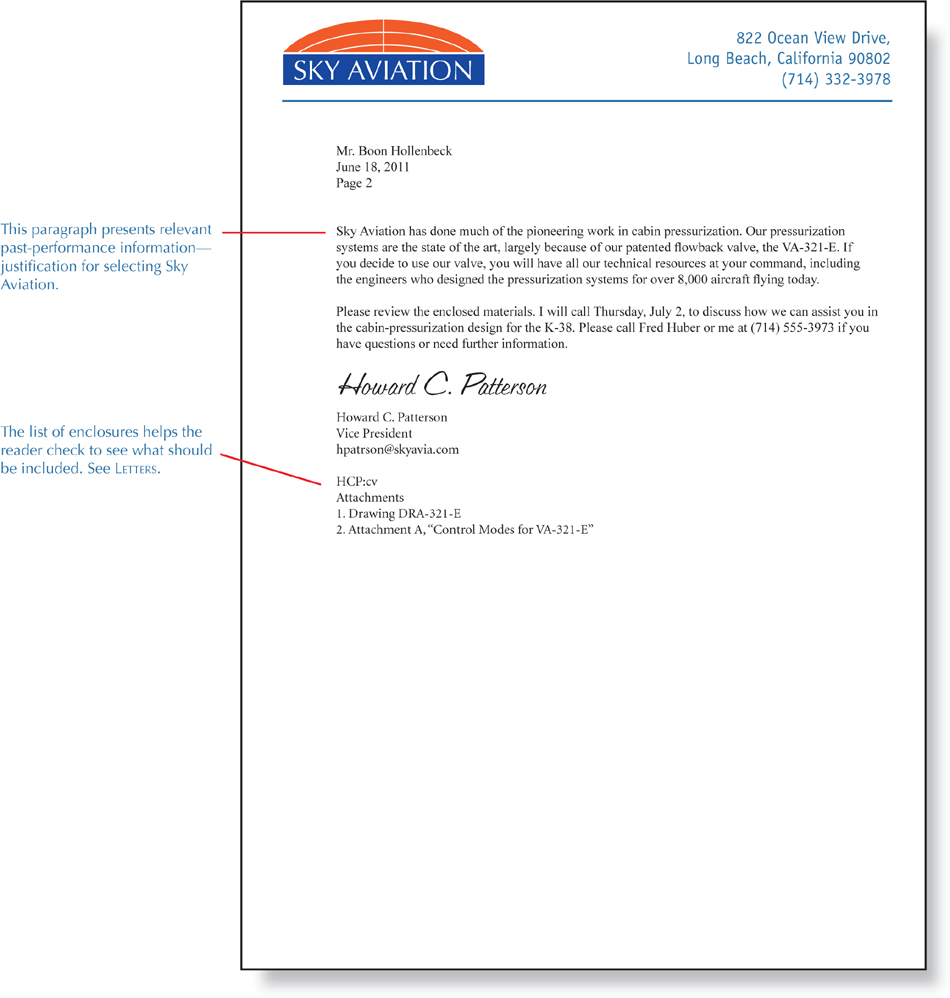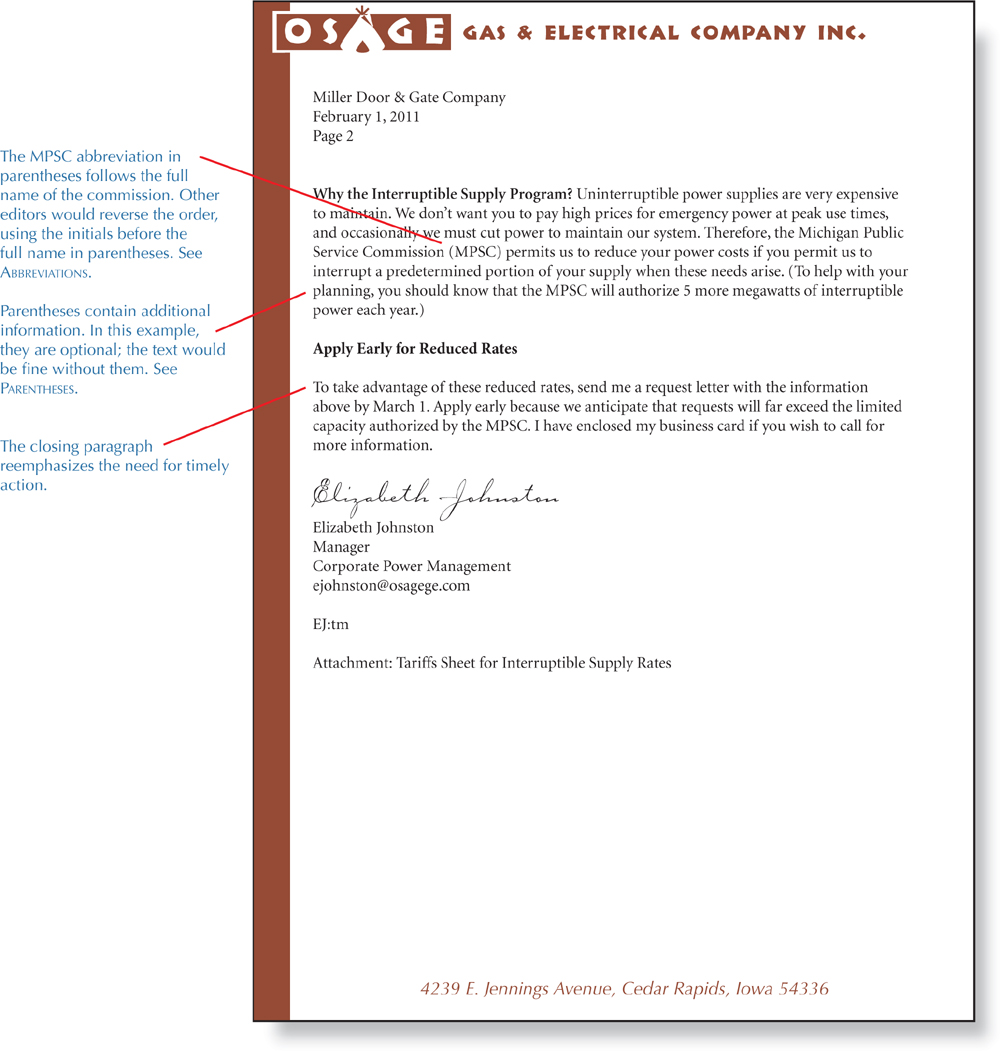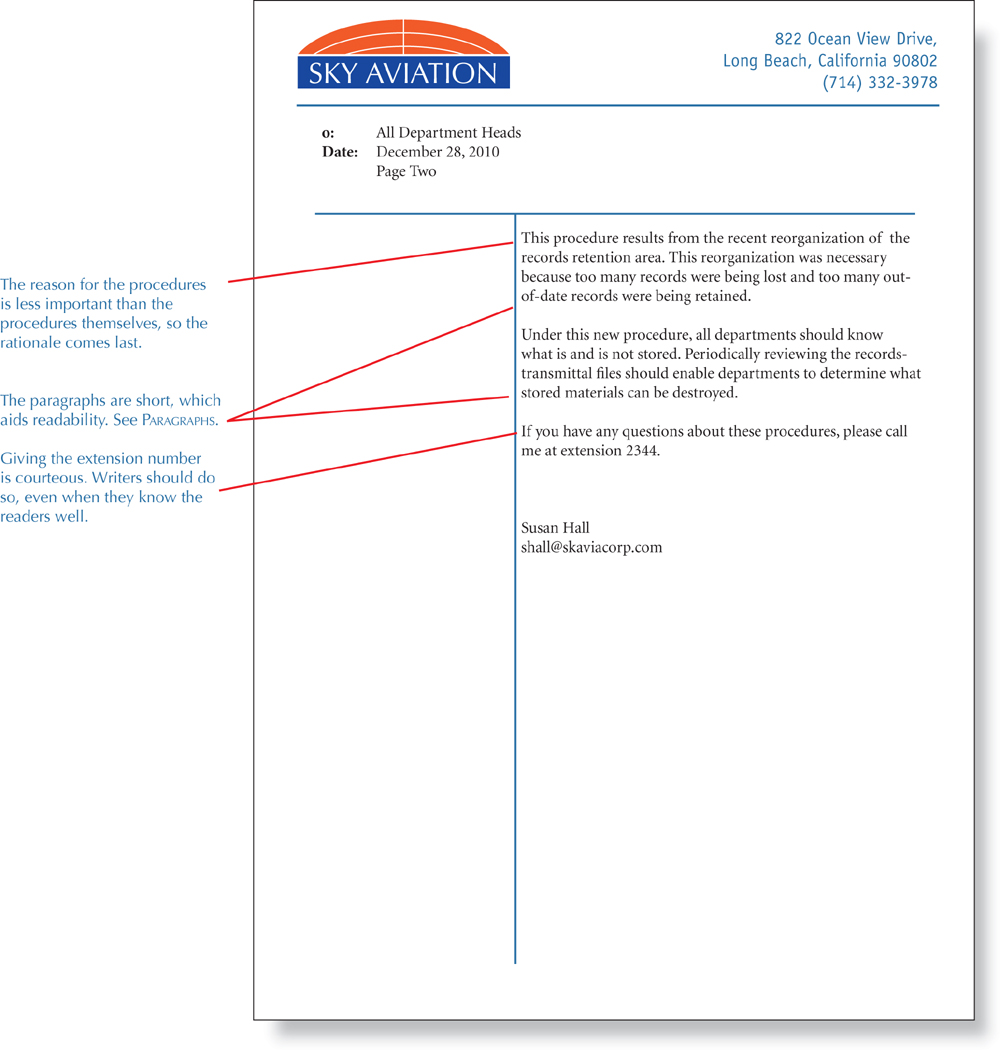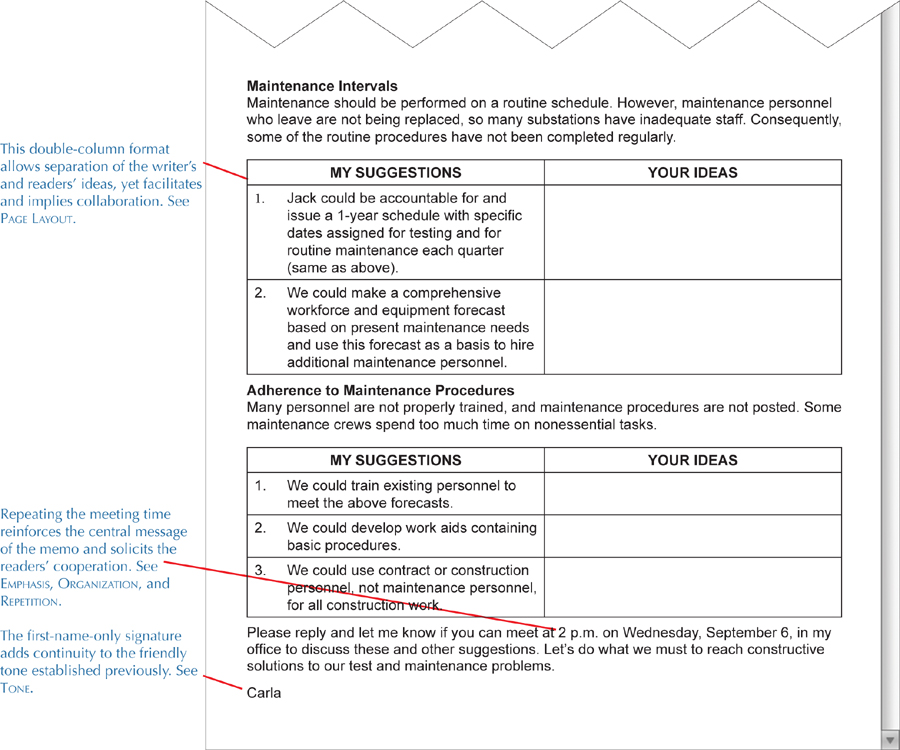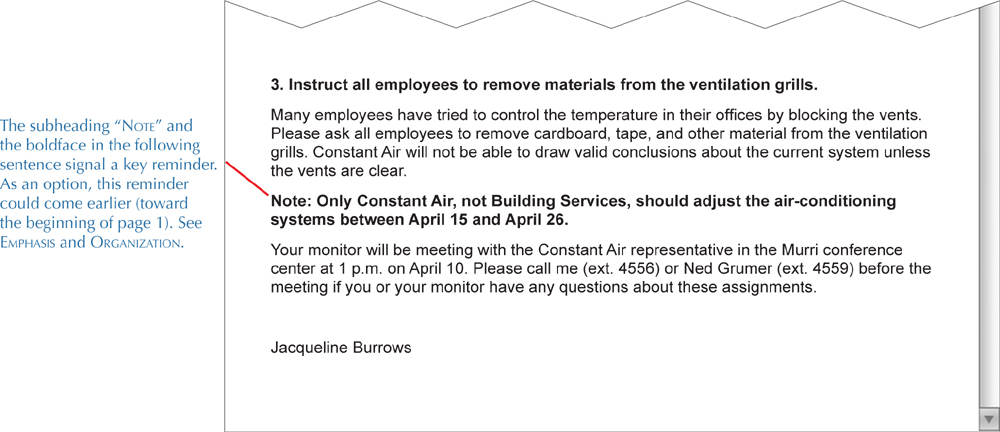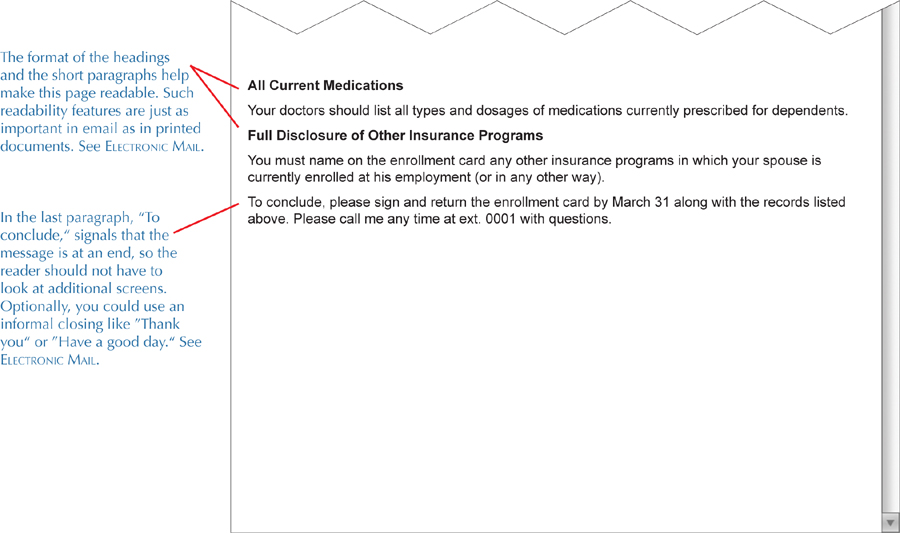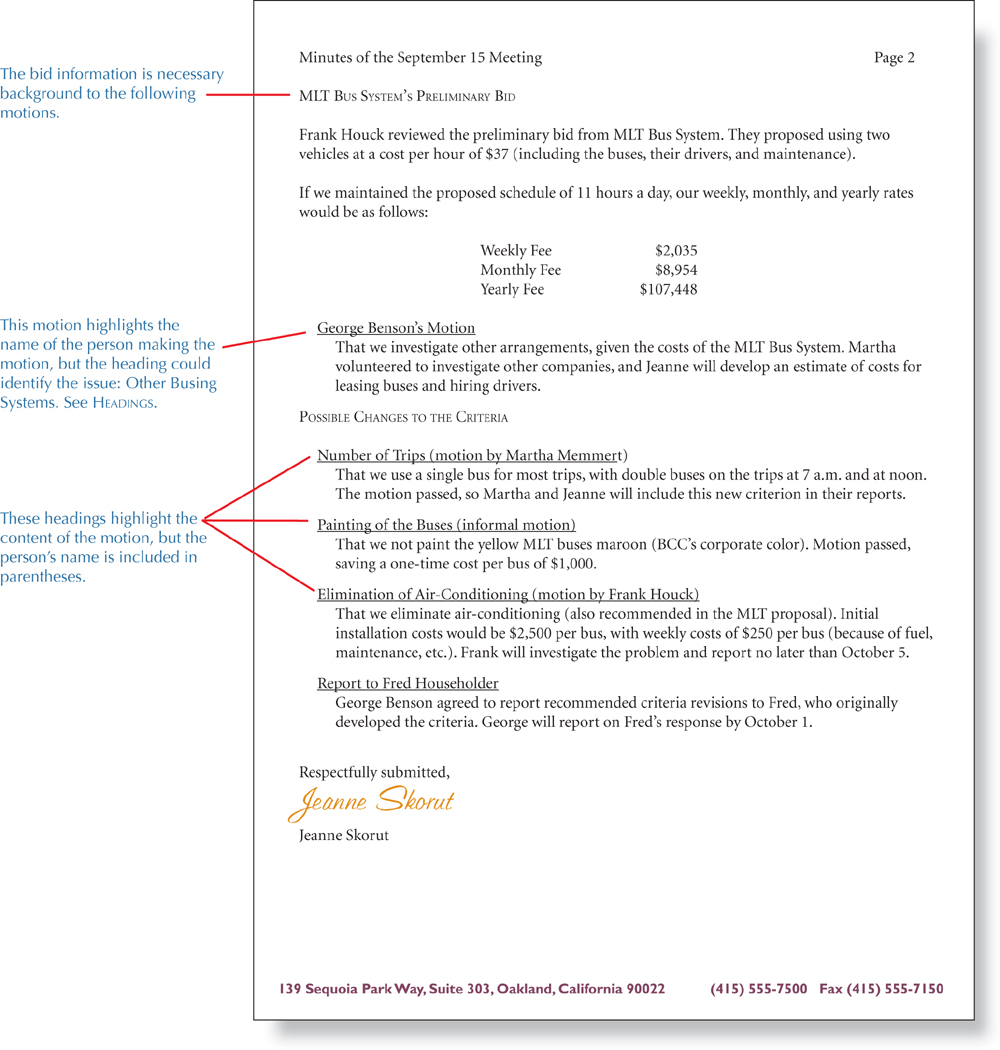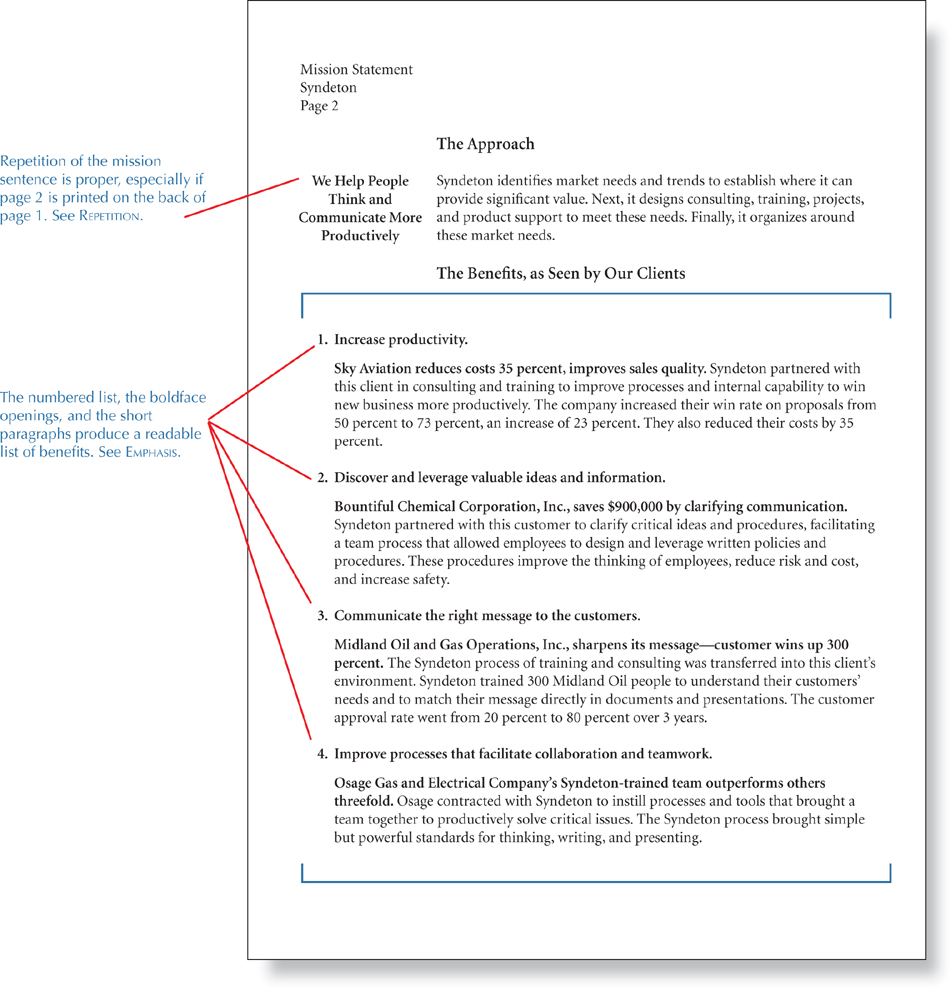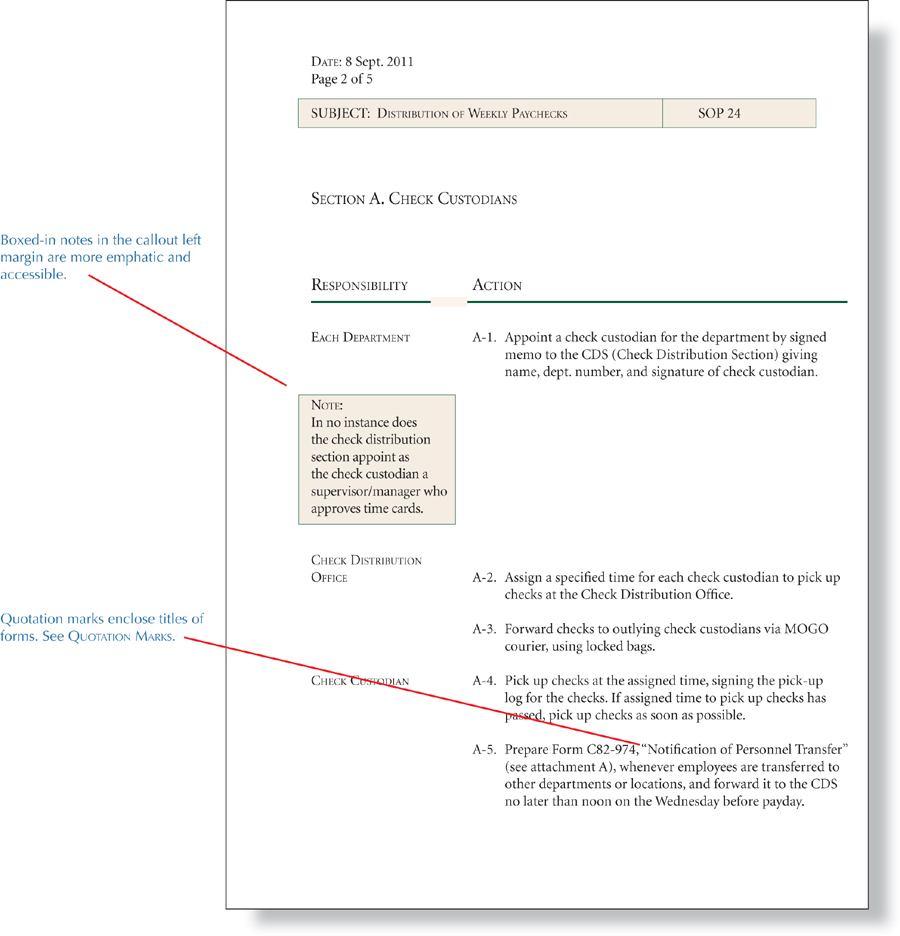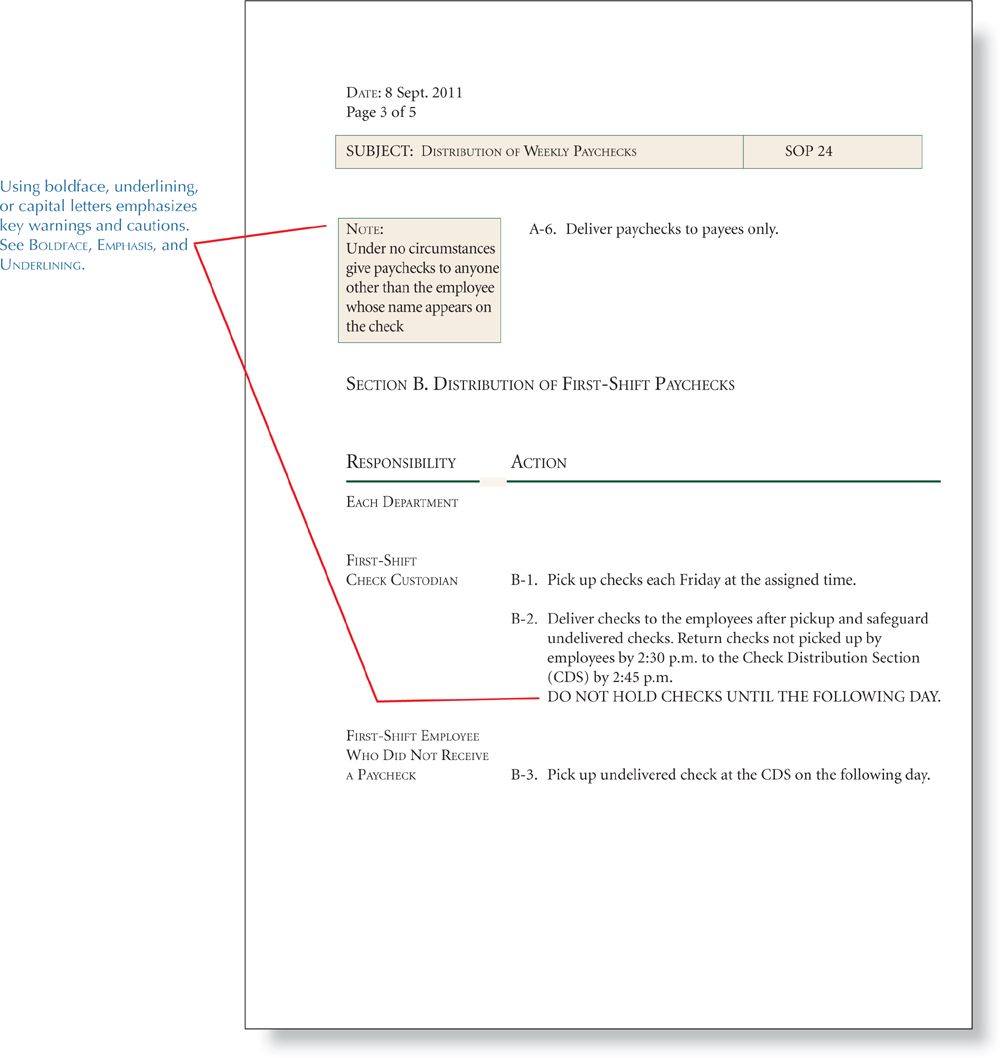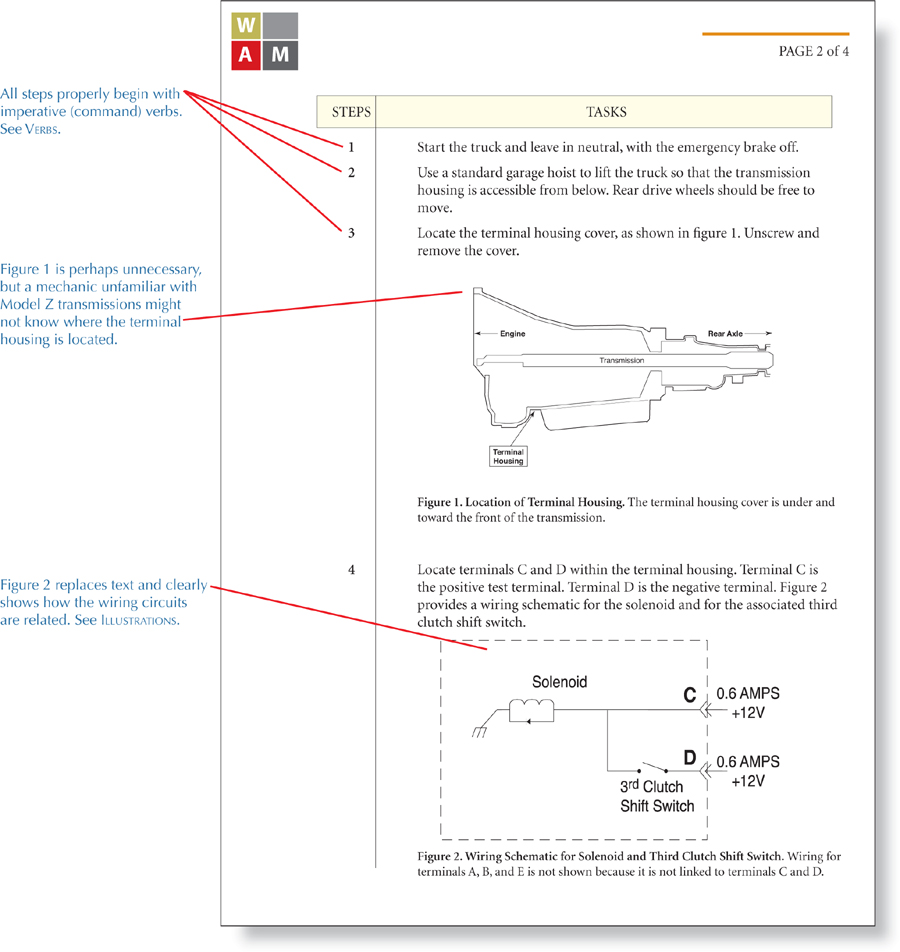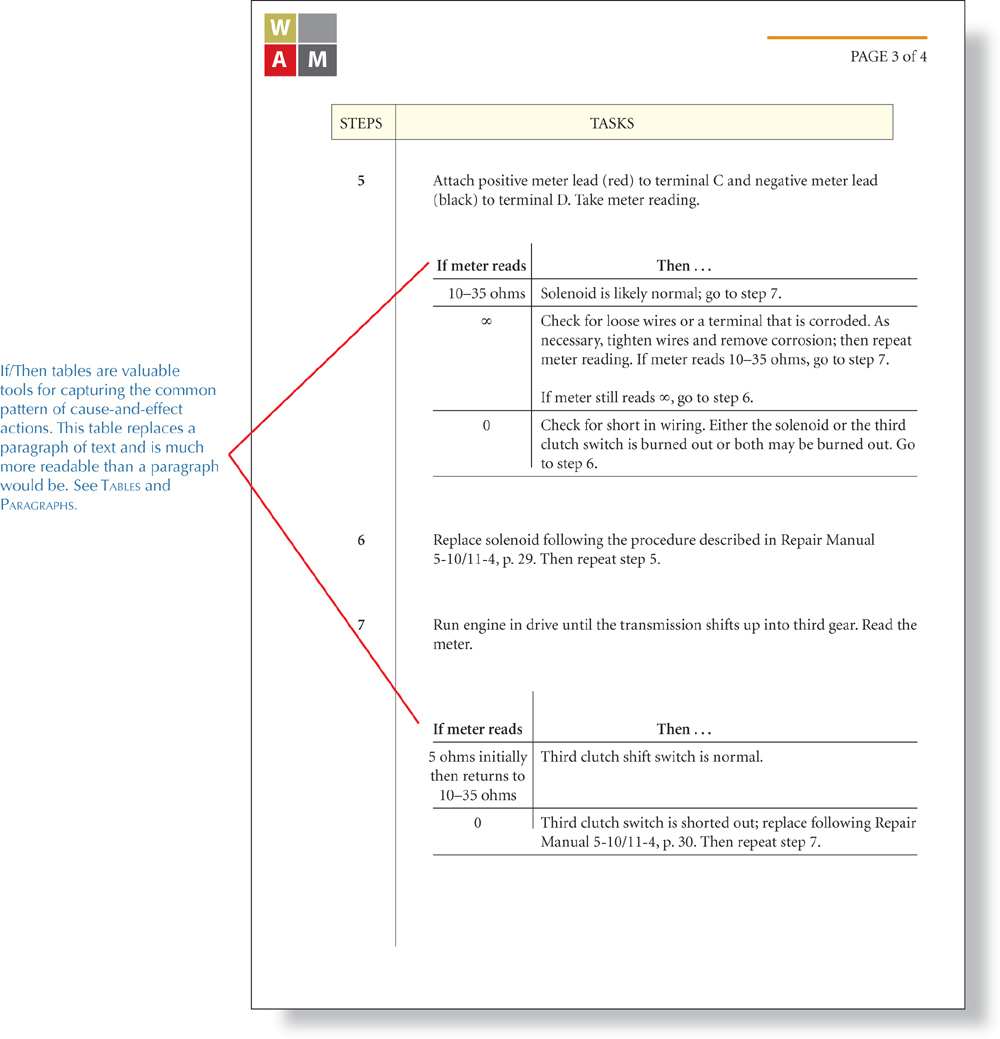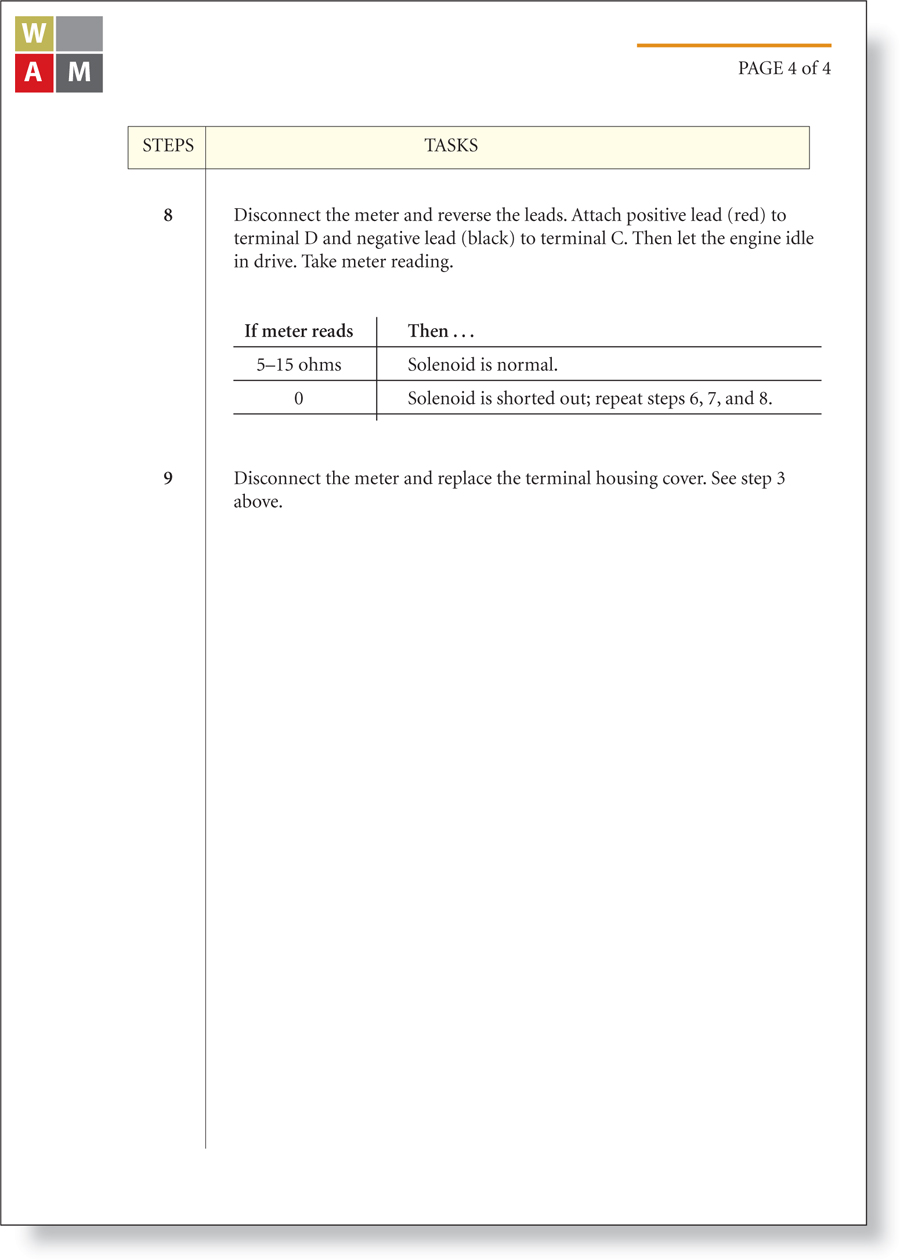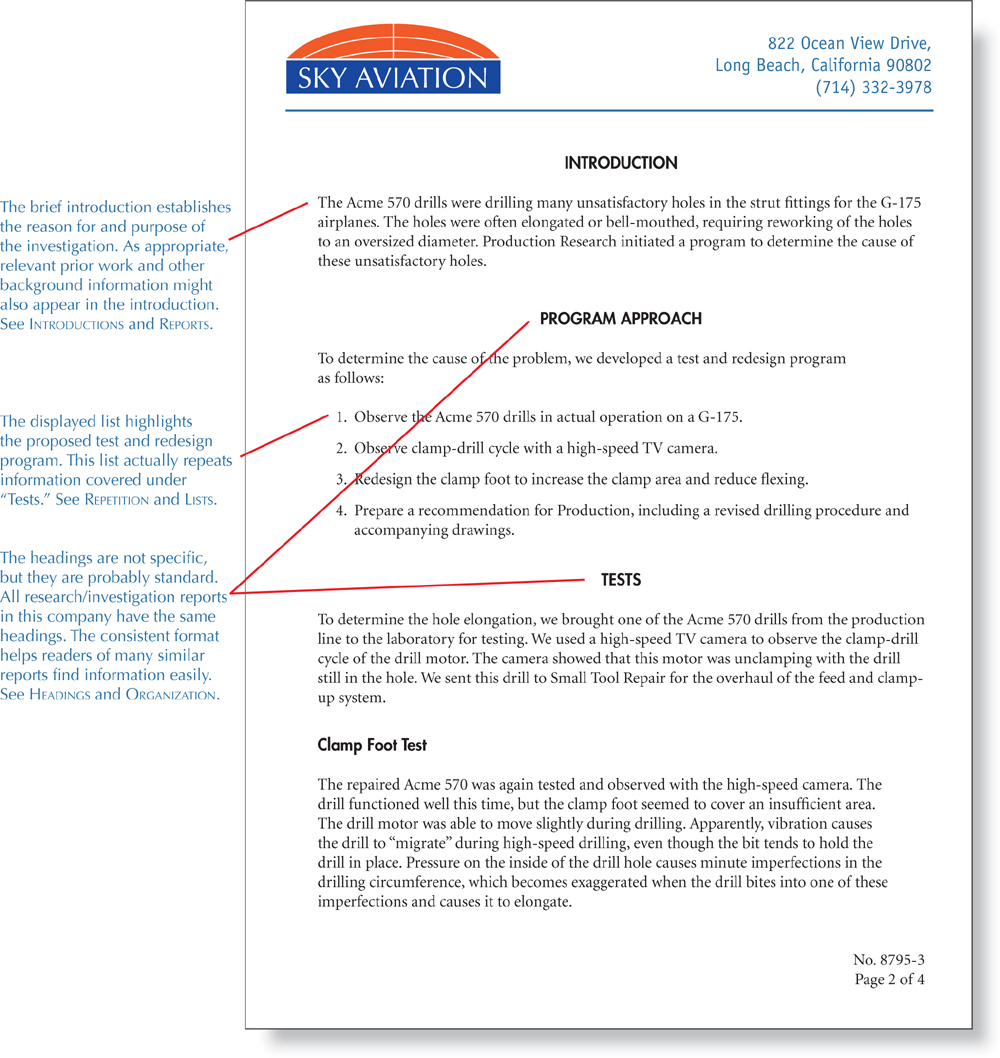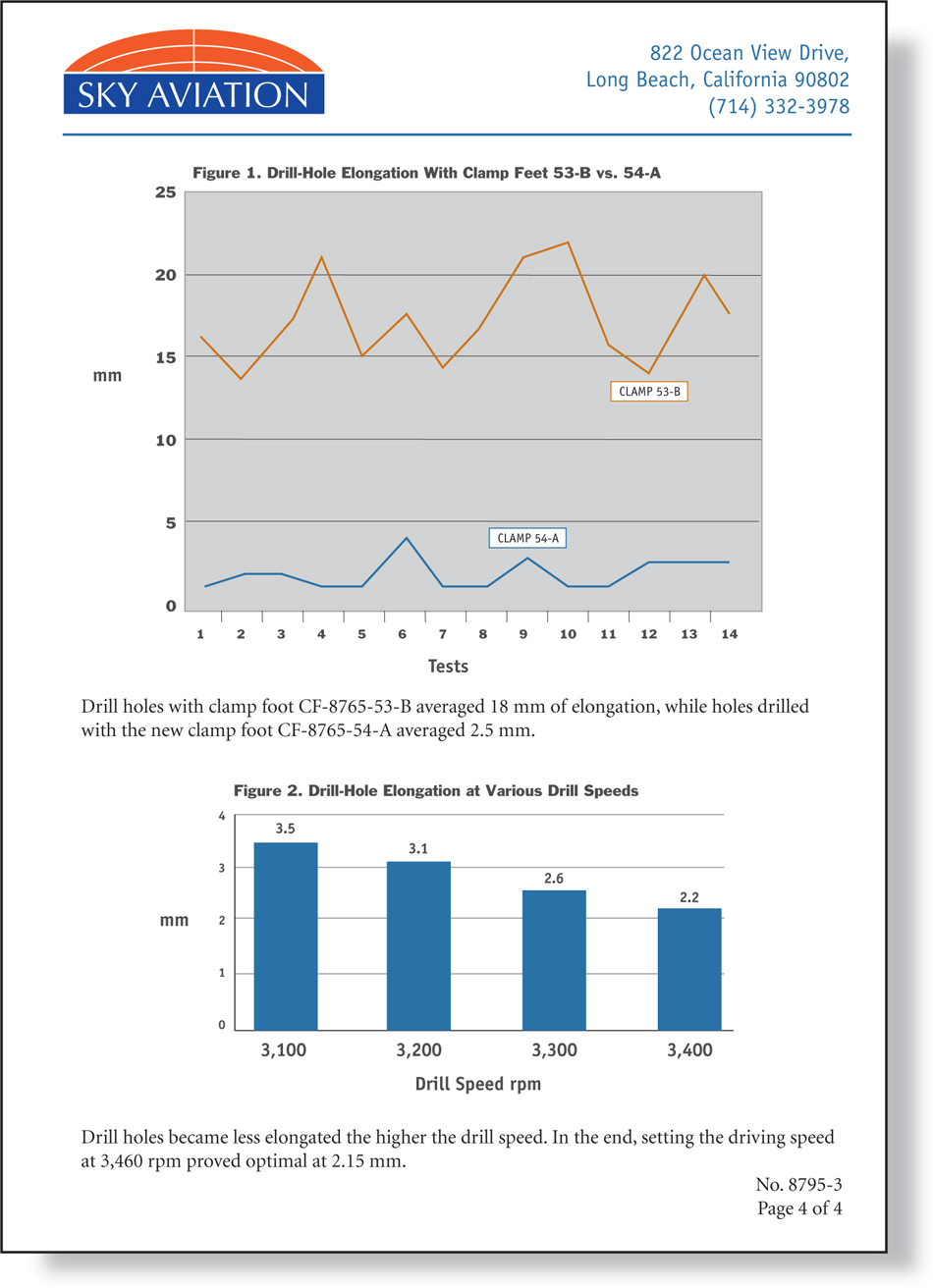Model Documents
Using Model Documents
The following models illustrate both effective document design and the best in current business and technical English.
As you survey these models, you will notice that they all use headings, informative subject lines, lists, short paragraphs, color and, whenever appropriate, graphics. The goal of these emphasis techniques is to make the information in these documents 100 percent unambiguous to any and all readers.
This goal is, of course, not achievable. Not all readers read accurately or consistently. Still, writers of documents must do everything they can to assist readers both to discover accurately the information in a document and then to remember this information for later use.
Well-designed documents are the single best tool for making sure readers receive unambiguous information. See EMPHASIS.
The following suggestions should help you use these models to improve your own documents.
• Use these models as a source for document design ideas, not for exact words and phrasing. Most of the time, you will find that your own topic or content will not match the words and phrases in a given model.
• Choose words and phrases that sound like you, not like someone else. The best business or technical style is usually the one that is natural, even conversational. See STYLE, TONE, SCIENTIFIC/TECHNICAL STYLE, and LETTERS.
• Refer frequently to the “Reference Glossary” section in this Style Guide. As in the preceding suggestion, all models cross-reference entries in the “Reference Glossary.”
• Begin your own collection of models, ones that reflect your own professional content and organizational conventions. Then refine or polish these models each time you use them, referring, as necessary, to the principles illustrated in the Style Guide entries and models.
Response Letter: With Information and Directions

The bulleted list may not be essential if the attachments or enclosures are clear. See ORGANIZATION and LISTS.
The writer provides all necessary information to ease cooperation in the response—for example, a personal phone number (closing paragraph) and an email address.
Response Letter: To a Concerned Customer
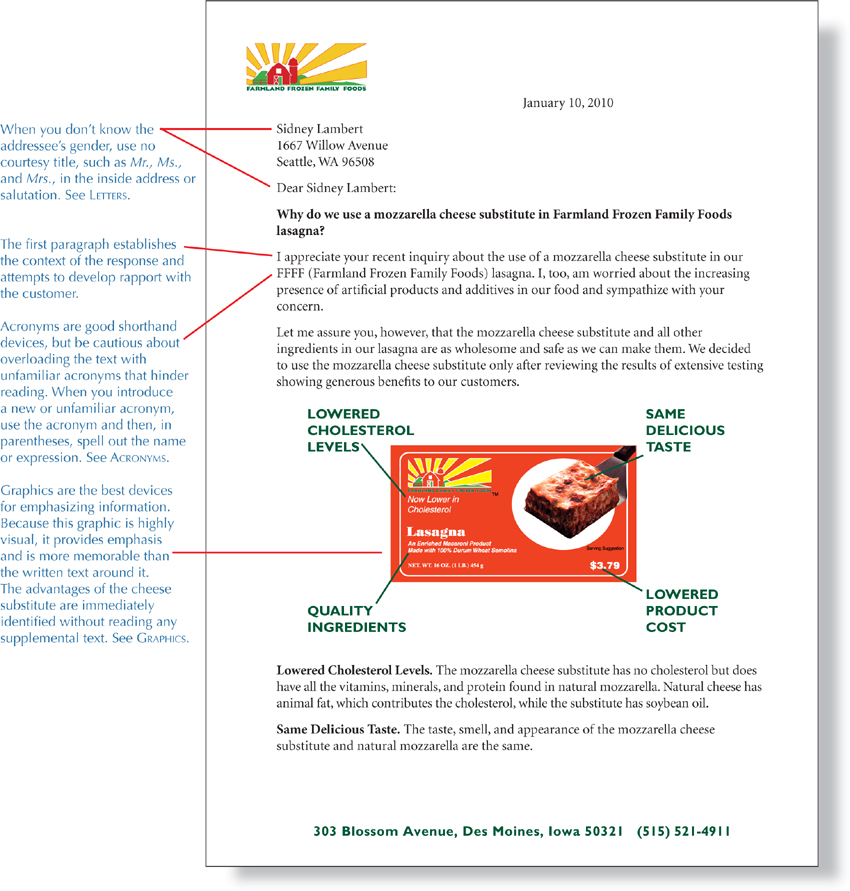
Letters responding to customer complaints should be as personal and direct as possible. The writer must address all questions or grievances in the reader’s earlier letter and must do so in a friendly, sympathetic, and courteous manner.
This letter illustrates the modified block style, which is not commonly used in business today. The date, complimentary closing, and signature block appear right of center; everything else is flush left. The paragraphs are not indented.
Although this letter is a response to a concerned customer, it also presents an opportunity to sell a product. The writer designs a message that speaks clearly, effectively, and persuasively to the customer. See PERSUASION.
The personal pronoun I is appropriate, even though the writer is speaking for FFFF. She shifts to the collective we when she speaks for the company as a whole. Such shifts in pronouns are natural and acceptable. See TONE, LETTERS, and PRONOUNS.
Response Letter: To a Complaint
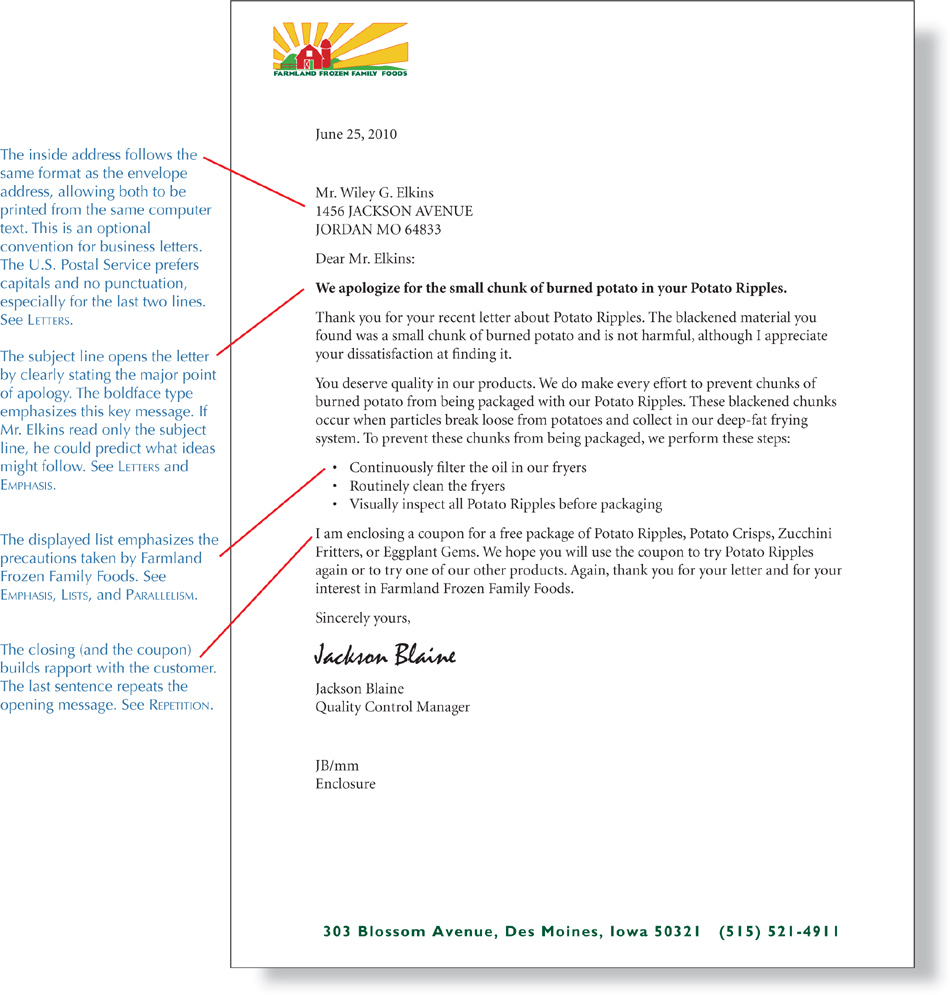
Tact and a personal touch are crucial in letters to disgruntled customers. Personal pronouns help establish a tactful tone, and the details include specific references to Mr. Elkins’s letter without repeating the negative events verbatim. See PRONOUNS and TONE.
The writer avoids technical complexity and jargon (he might have called the chunk of potato a “carbonized carbohydrate particle”). See JARGON, GOBBLEDYGOOK, and SCIENTIFIC/TECHNICAL STYLE.
Complaint Letter: With a Request for Action

Use tables to give readers exact figures or to permit readers to compare figures or other information. Tabular information is usually more understandable than the same information presented in text. See TABLES.
As in this letter, complaint letters usually start with a concise statement of the problem followed by a request for action or resolution. The problem statement should be as brief as possible but long enough to make the request understandable. See the discussion of setups in ORGANIZATION.
Complaint Letter: With a Tactful Request for Aid
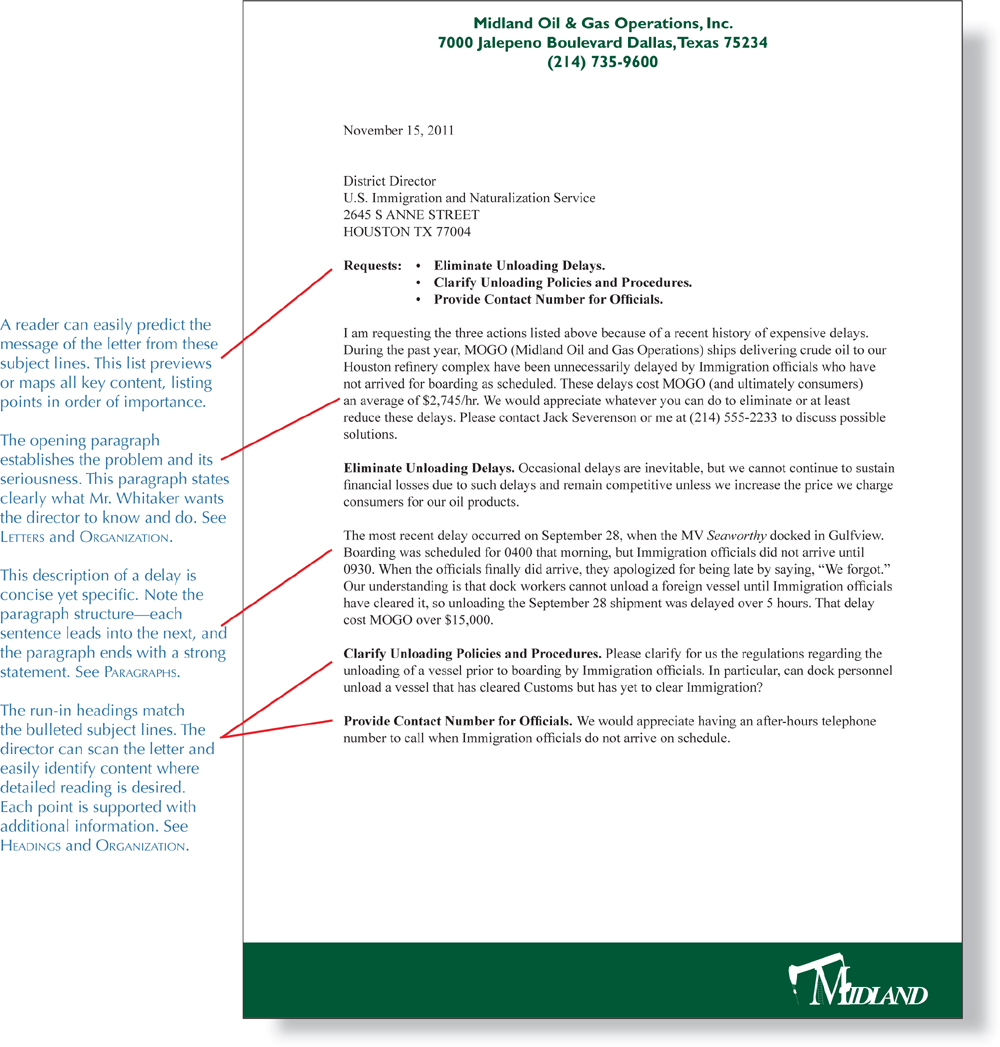
Complaint letters have to be tactful yet firm. They are usually based on one or more incidents, which must be established before you can request a remedy. The opening sentences of the first paragraph provide background information to establish the nature and seriousness of the problem. The request that follows is therefore understandable and reasonable. See ORGANIZATION and LETTERS.
Tone in complaint letters is important. Such letters should not sound shrill, angry, or unreasonable. In this letter, the author writes calmly but directly. He presents a specific case and then makes several understandable requests. The letter ends with a plea for cooperation. See TONE.
This letter illustrates the simplified format. The simplified format omits the salutation and the complimentary closing. This format is appropriate in cases where you don’t have a name for the addressee, or the addressee is a title or a company department.
Employment Reference Letter
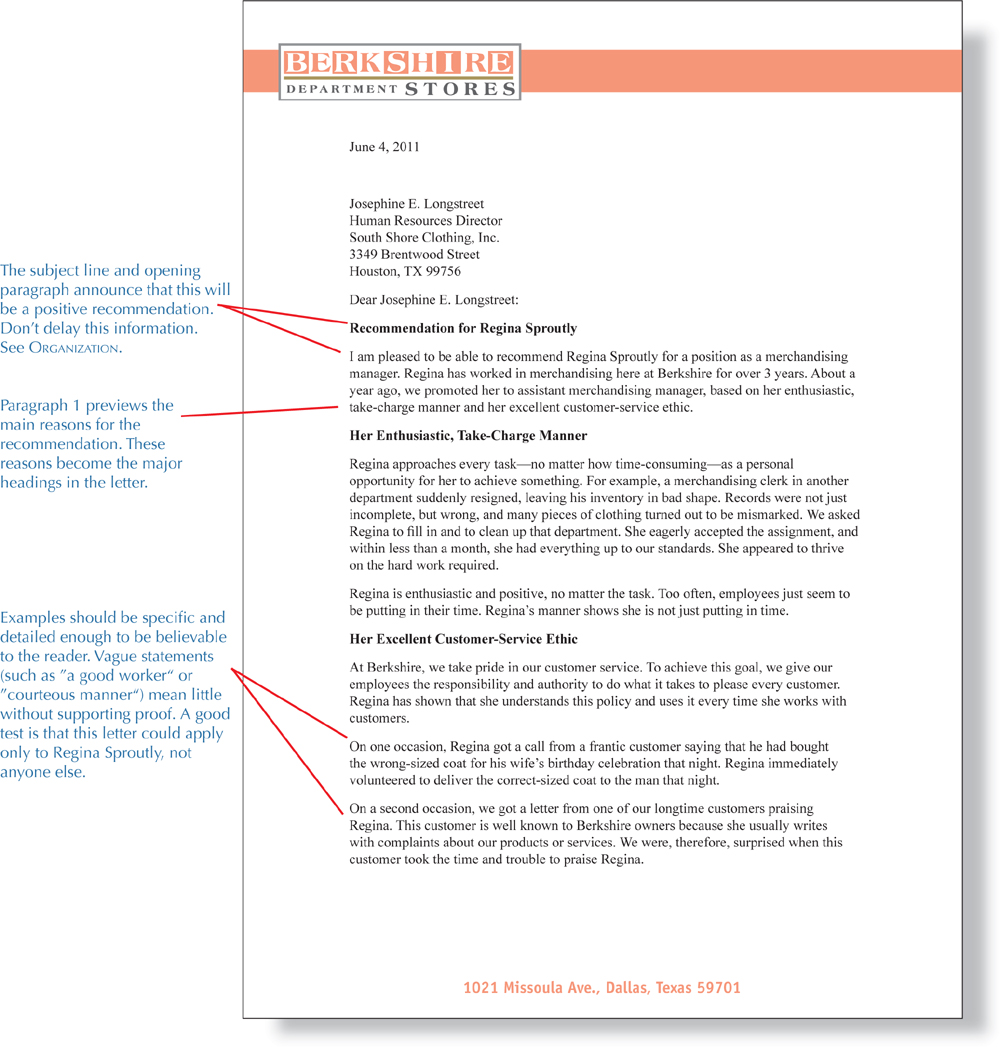
Reference letters are a vanishing custom in the business world. Because of possible legal questions, many companies now have policies that prevent any manager from writing a reference letter. At the most, a manager or human resources specialist will write a letter verifying a person’s employment status, but making no statements about the person’s skills or abilities. (See the verification letter following this reference letter.)
Also, be aware that if you write a reference letter, the person discussed in the letter may have a legal right to see the letter. So do not consider your letter confidential or privileged.
If you need to write a reference letter, be honest and be specific. You should honestly cite specific examples of the person’s abilities and accomplishments. If you do not have positive examples, we recommend that you tell the applicant to find another person to write the recommendation letter. Also, if you praise someone falsely, you open yourself and your company to legal liability if that person is hired based on your letter and then has problems in the new job. See ETHICS.
This letter illustrates the full block format, with all parts of the letter flush left. See LETTERS.
Employment Verification Letter
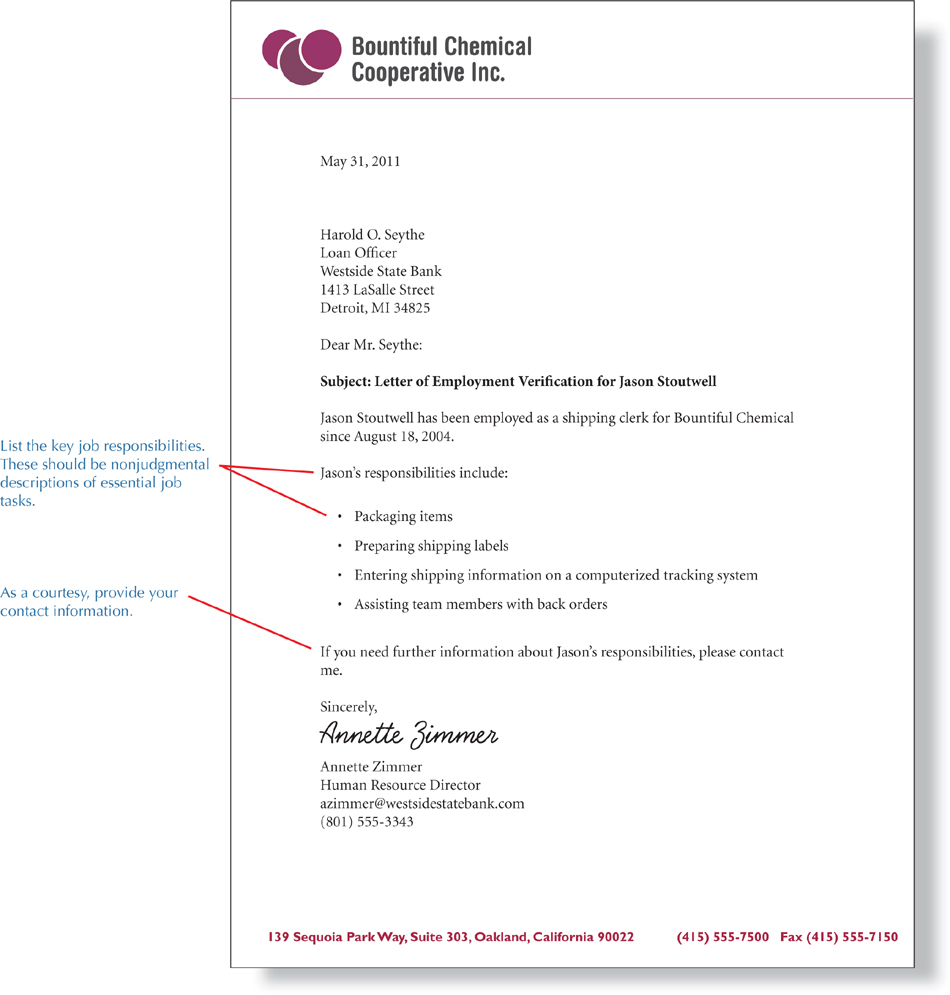
Use an employment verification letter when employees need you to verify their position(s) and their dates of employment. Banks often request such letters. Also, insurance companies often request such information when they are verifying insurance status (especially when an employee has double coverage or the employee’s spouse has overlapping coverage).
A verification letter is not a reference or a recommendation letter in the traditional sense. See the preceding model in this Style Guide for an example of a reference letter.
Bid Solicitation
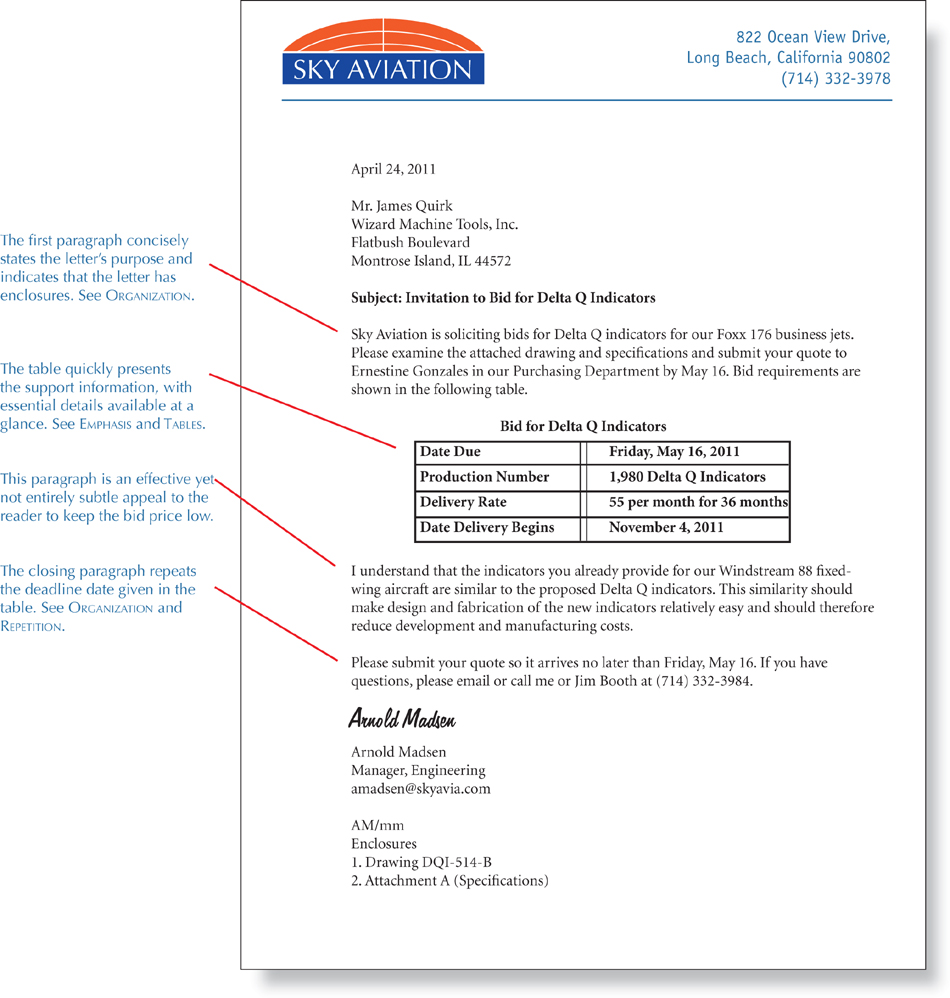
This letter features a classic letter design: a concise opening that clearly indicates the letter’s purpose (to solicit bids); a crisp middle with details appearing in table form and a short, well-designed paragraph; and a courteous closing that repeats the deadline and ends with an offer of assistance. See LETTERS and ORGANIZATION.
Some company letterheads display Internet or email addresses as part of the address line. But most frequently, the address is placed in the text of the letter or just below the signature block, as shown above.
This letter illustrates the simplified format. See LETTERS.
Sales Letter: With a Soft Sell
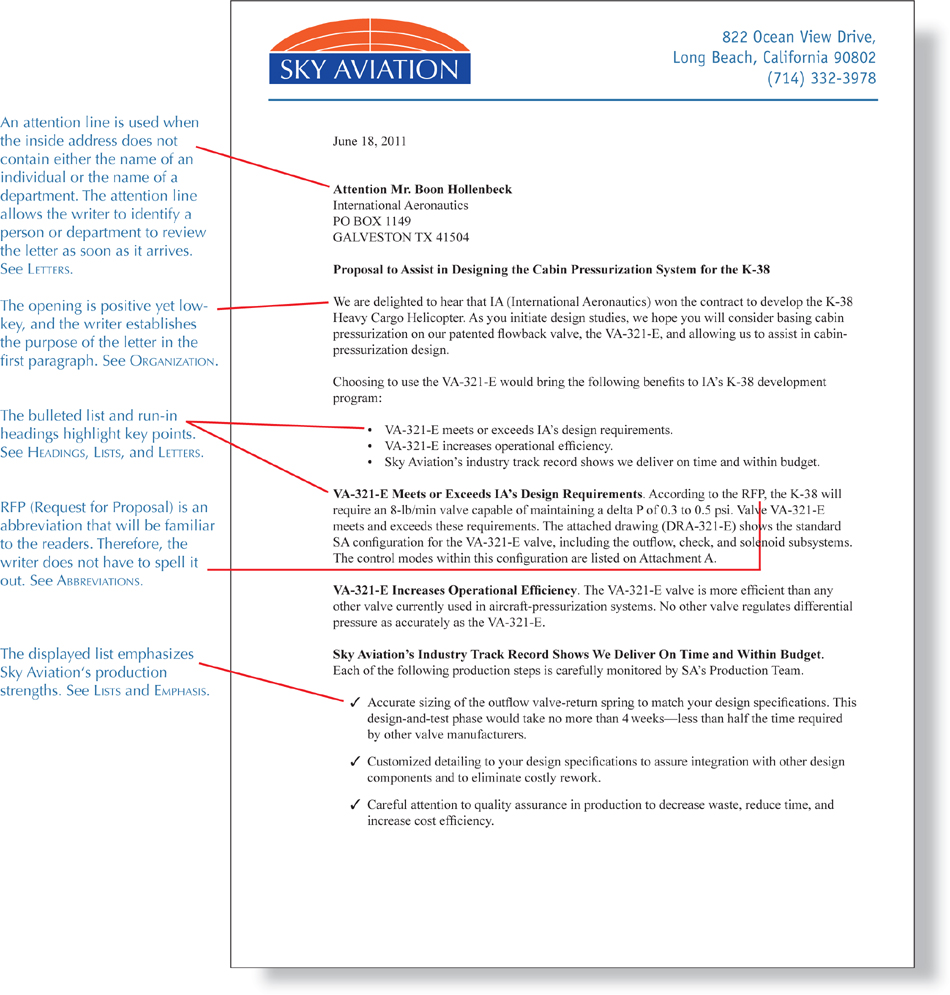
The attention line has traditionally been placed two spaces below the inside address. Instead of this traditional placement on envelopes, the U.S. Postal Service prefers that the attention line be placed above the company name, the street address, and the city and state. To be consistent in the letter, the attention line is placed as the first line of the inside address. See LETTERS.
This letter illustrates the simplified format. See LETTERS.
A sales letter is a blend of fact and sales pitch. Presenting information positively is essential, but sincerity and realism are also necessary ingredients of successful sales letters. See PERSUASION. This letter opens and closes with a soft sales pitch. The technical information in the middle is emphasized by boldface headings. The writer’s goal is to make the technical information seem substantial and convincing. See EMPHASIS, SCIENTIFIC/TECHNICAL STYLE, and TONE.
Sales Letter: With a Soft Sell—Attachment
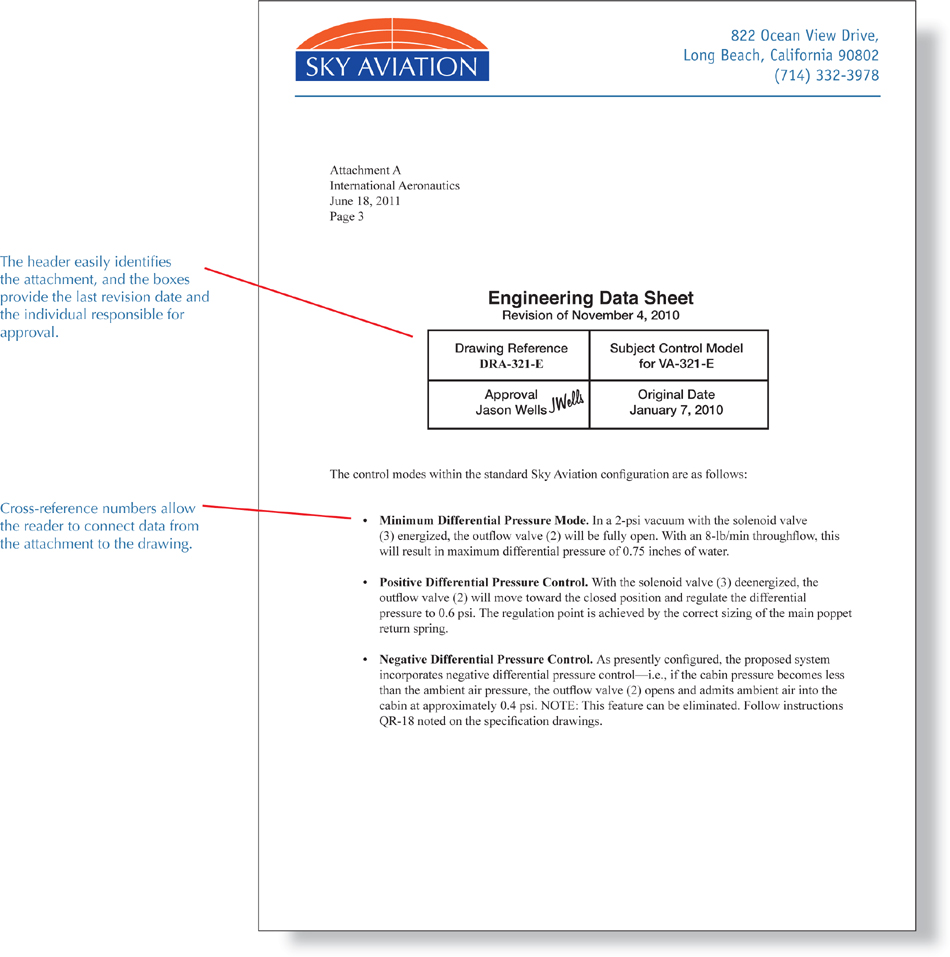
Drawing DRA-321-E and Attachment A come from the engineering design team. The drawing and attachment provide necessary information to the sale. To determine if an attachment is justified, ask the following question: “Would a knowledgeable reader need the information in the attachment(s) to interpret the conclusions and recommendations?” If the answer to that question is yes, the attachment is justified. See APPENDICES.
NOTE: Drawing DRA-321-E is omitted.
Sales Letter: Template/Mail Merge
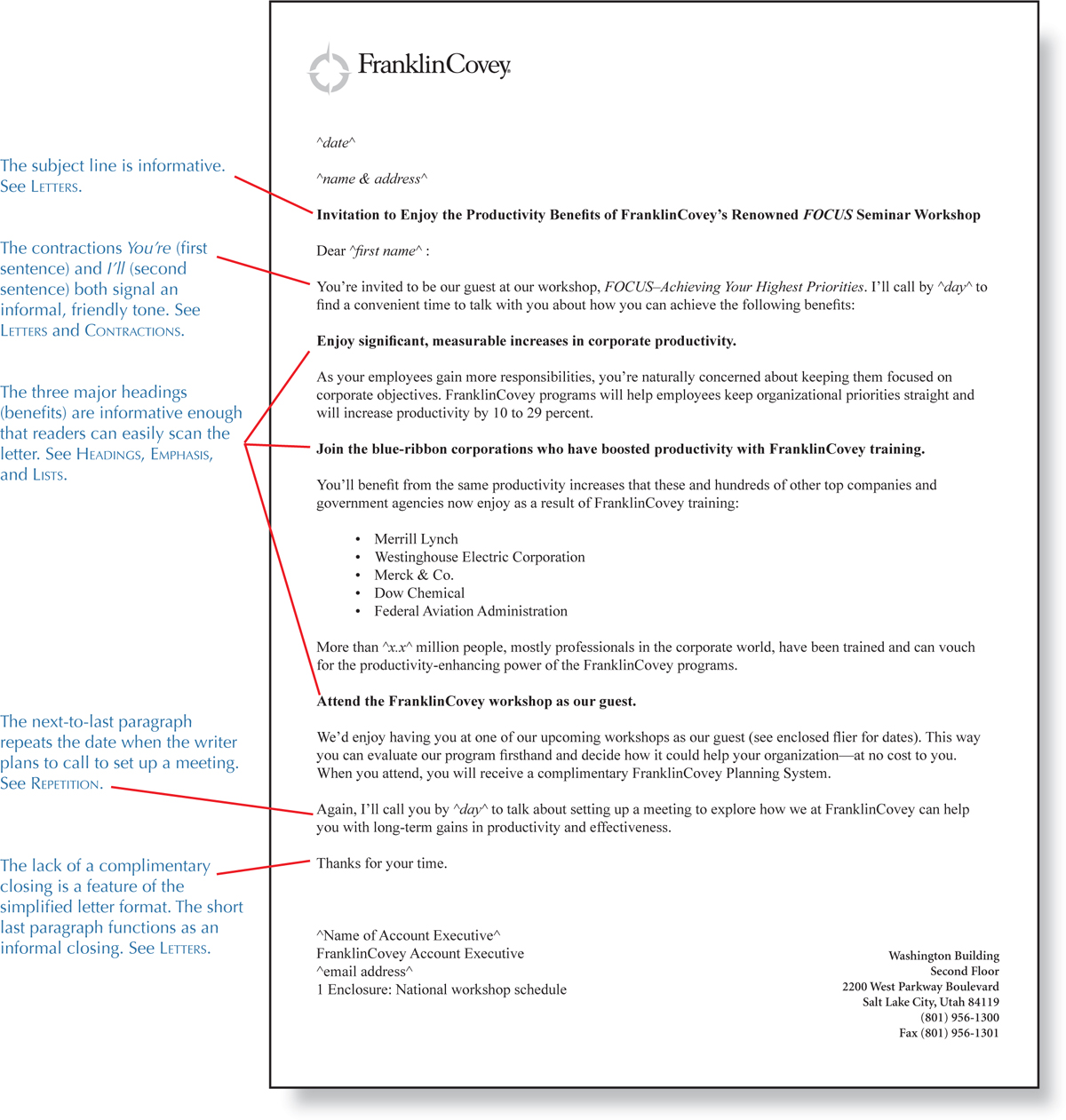
A template is a document model or shell that writers can tailor to their own specific needs. Most software programs allow you to copy a template and then rewrite or revise it to fit your needs. Other software programs, similar to the pattern illustrated above, have blanks for you to provide information. This information, once typed in, merges into the letter, so you don’t have to do any revising or rewriting.
Customer Service Letter
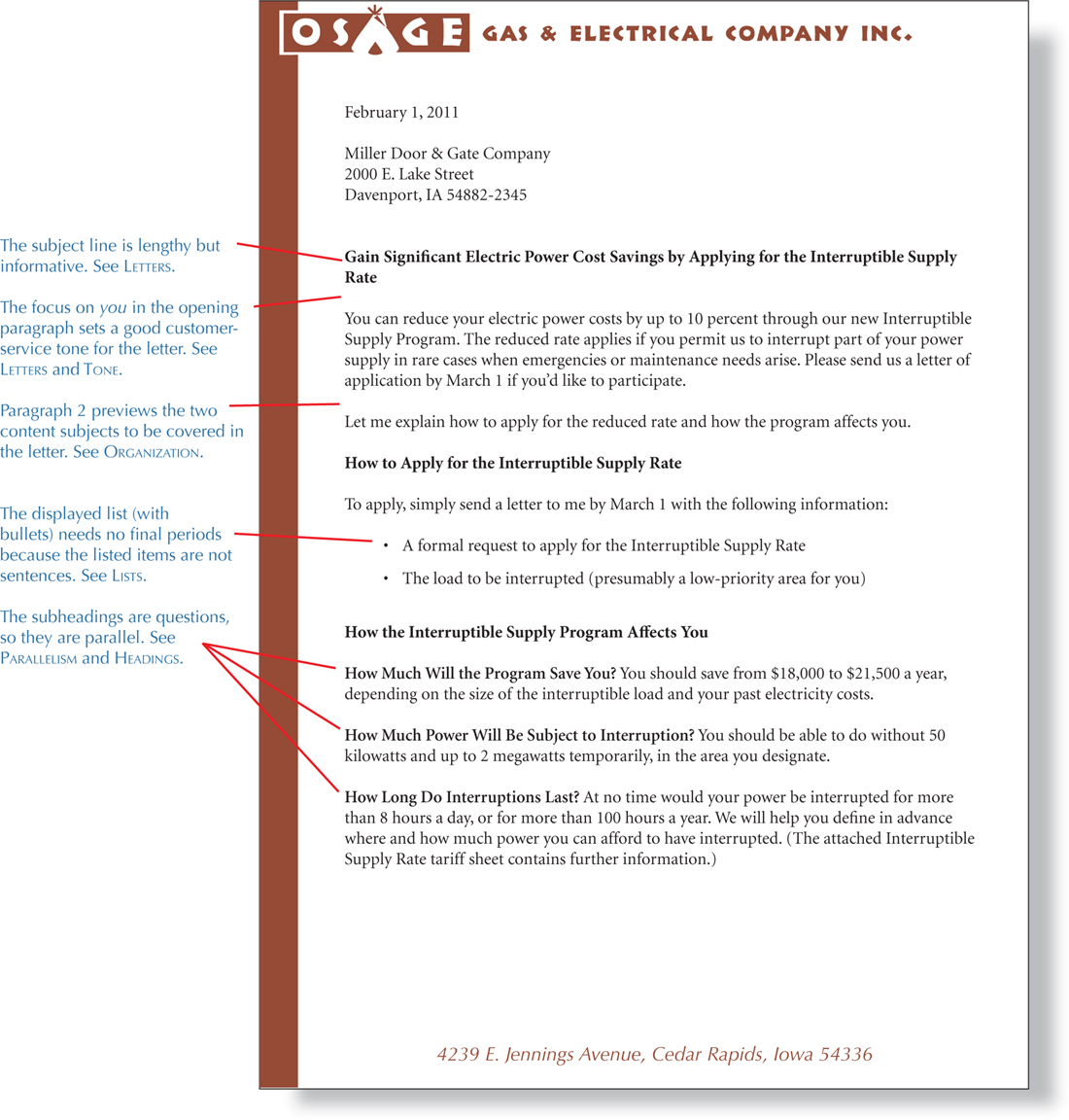
This customer letter is a combination of service information and an indirect sales request for companies receiving it to apply for the reduced rate. As such, it is more factual than persuasive, although some sentences highlight sales benefits. See PERSUASION and TONE.
The letter follows the four-box letter organization. Box 1 (paragraph 1) opens with a request or a statement of purpose. Box 2 (paragraph 2) summarizes or lists the points to be covered. Box 3 (the remaining paragraphs, except for the final one) expands on the points listed in box 2. Box 4 (the final paragraph) closes with a review of the content and a final request for action. See ORGANIZATION.
The letter follows a simplified format. See LETTERS.
Procedure Memo
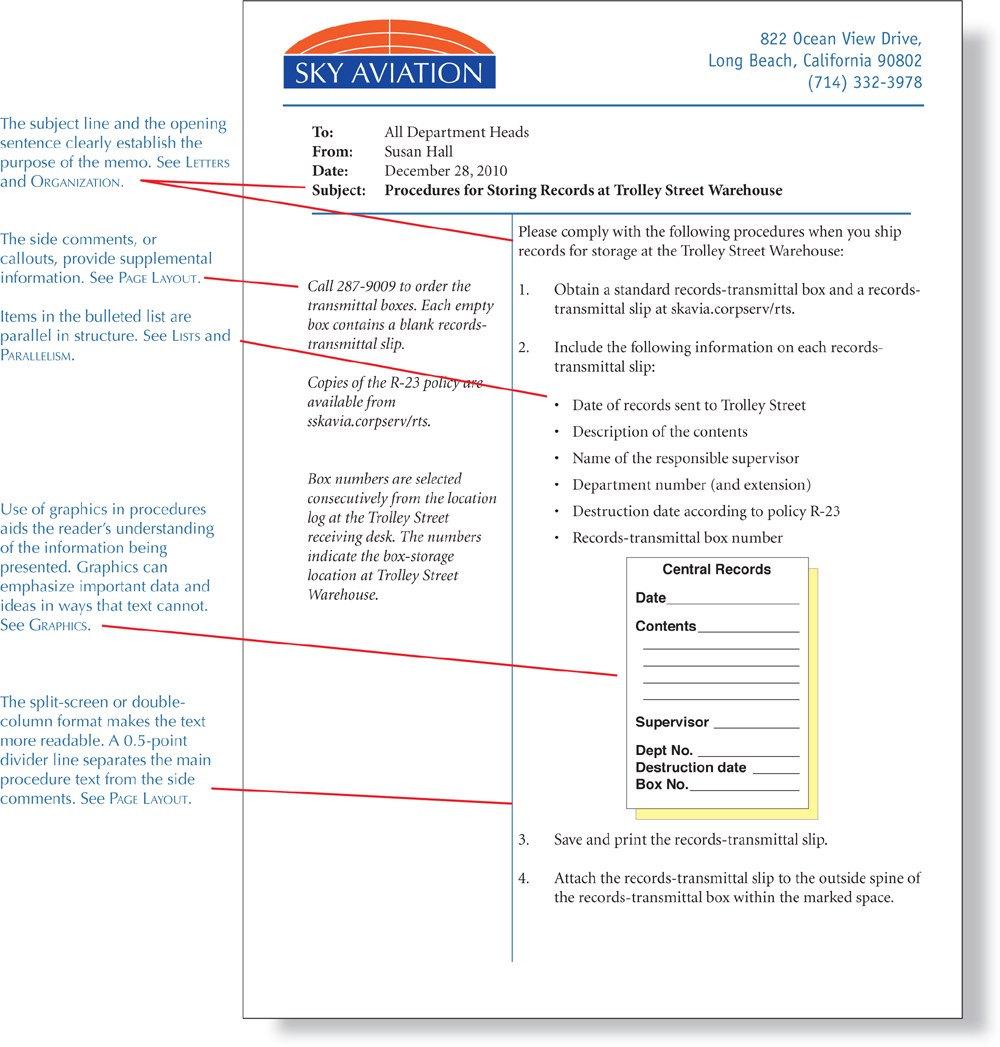
The imperative (command) verbs in the numbered list are essential in procedures. They highlight actions the reader should take, and they allow writers to condense their directions. For the sake of parallelism, state all directions or steps using imperative verbs. See SENTENCES and VERBS.
A clear format is essential in procedures. In this memo, the numbered and bulleted lists are crucial if the procedure is to be clear and readable. Each logical step must be complete and documented. Information gaps leave the reader unsure of what action to take.
See EMPHASIS and LISTS; also see the more formal procedures illustrated elsewhere in these model documents.
Request Memo: For Clarification of a Problem

While basically a request for information, this memo is potentially critical of the reader or people working for the reader. In such politically sensitive matters, tone is important. The writer must be forceful without being aggressive, direct but not blunt, businesslike but not inhuman. See TONE.
The headings basically provide a chronological list of events. Readers can easily glance at the headings and determine where they need to read more closely and where they can skim. See HEADINGS.
The deadline date is repeated in the closing paragraph. Restating a deadline or key point reinforces or emphasizes that key point in the reader’s mind. As you design your document and organize your ideas, build in effective repetition of your most important ideas. See EMPHASIS, KEY WORDS, REPETITION, and ORGANIZATION.
Summary Memo: For an Executive Audience
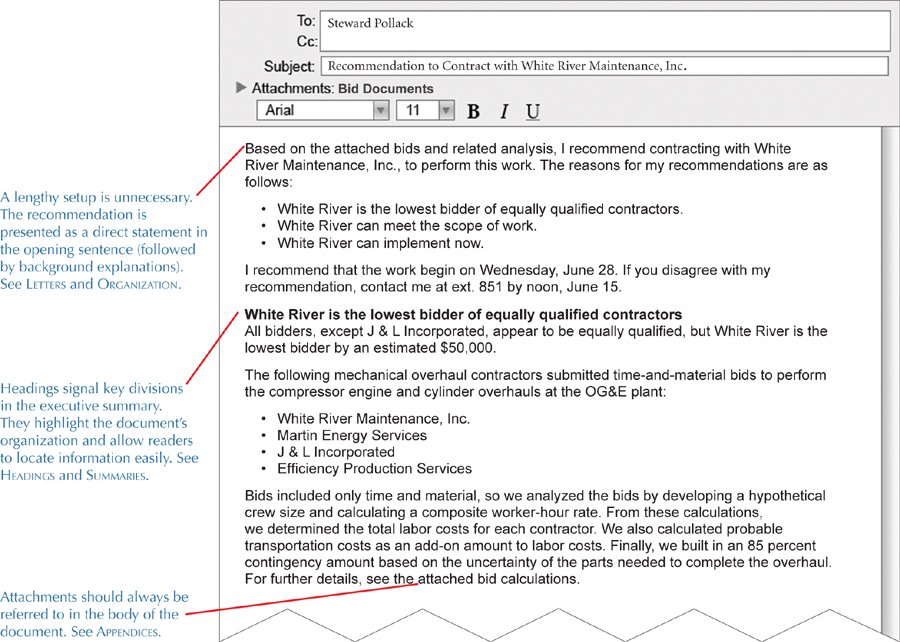
Many memos are actually summaries of attached materials. Such summary memos are similar to executive summaries, which open long, more involved reports. Readers of summaries are often managers and supervisors who already know something about the subject but who do not need extensive background information before making a decision. See SUMMARIES and REPORTS.
This memo (as in most executive summaries) does not need to contain extensive background data, calculations, supporting documents, and references. Such information should remain as attachments. See APPENDICES.
Proposal Memo: To an Antagonistic Audience
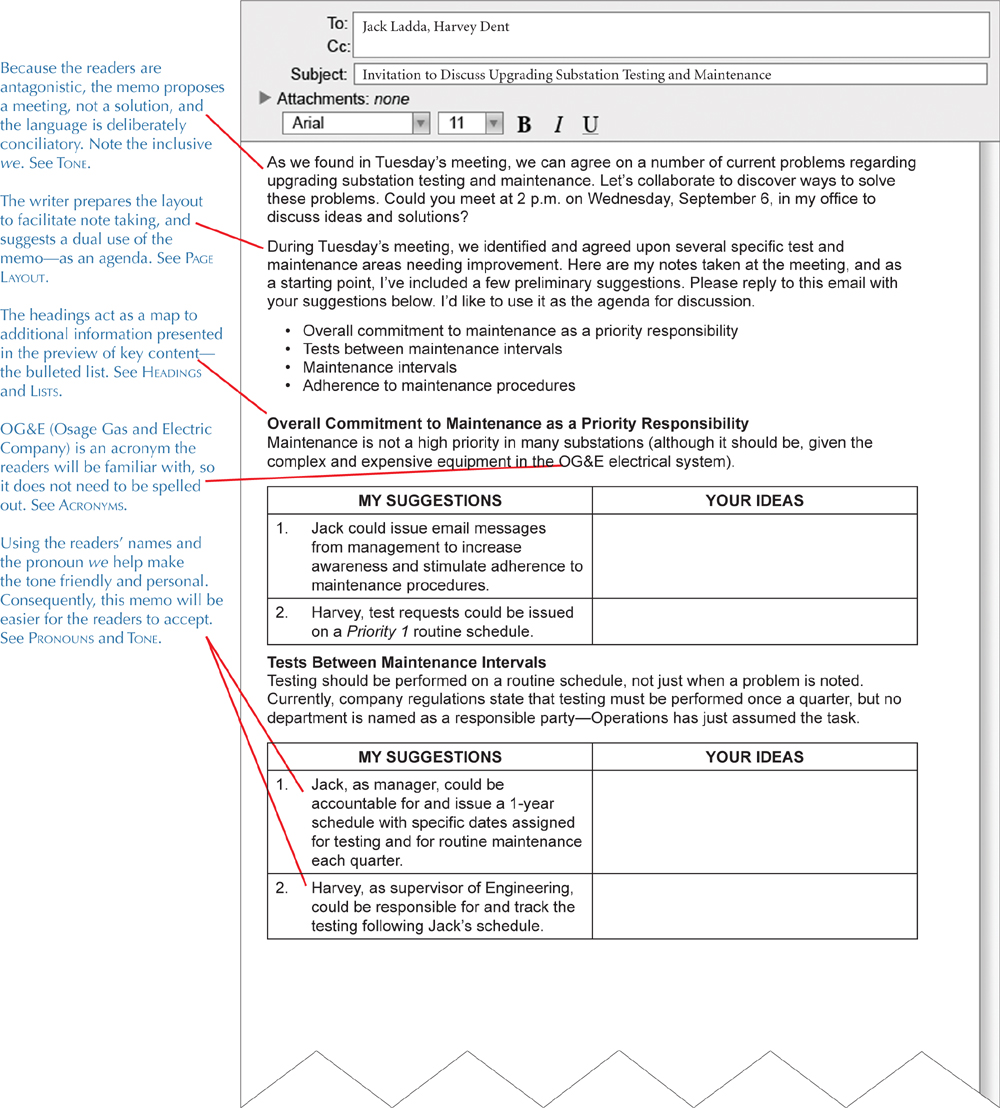
Because of the antagonistic audience, the writer deliberately makes his memo more tentative than it would ordinarily need to be. The opening paragraph is conciliatory, and the writer’s ideas are called preliminary suggestions, not proposals. See TONE.
Make your closing as simple and direct as your opening lines. You could close with a restatement of your main point, as shown in this memo, or you could refer to questions or problems, such as “Please call or write Neil Thornbush at (415) 555-01234 if you have questions about the proposed manufacturing schedule.”
Request Memo: With Informal Instructions
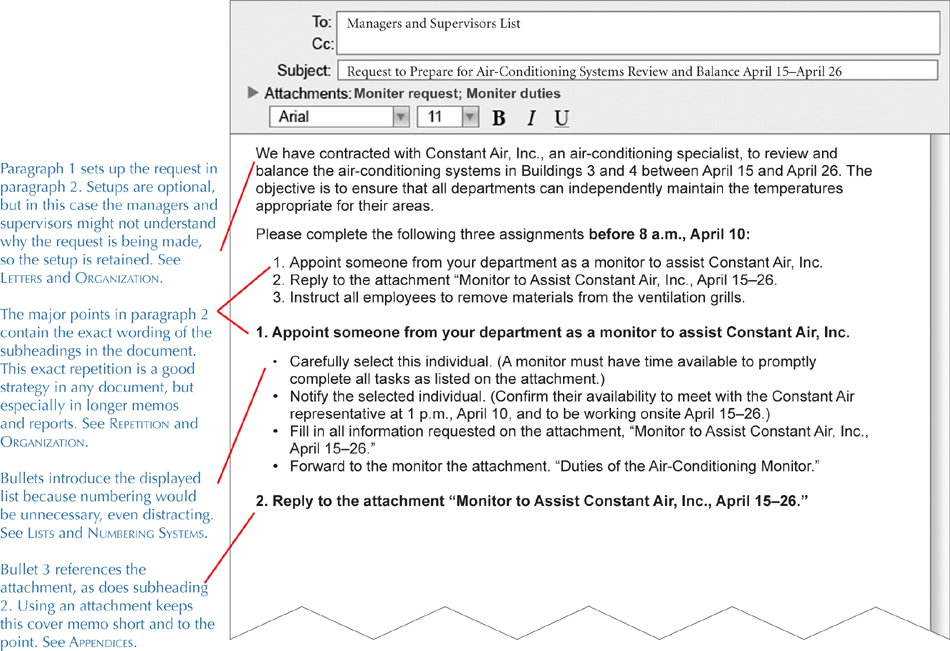
This memo and its attachments are typical of internal communications within a company or division. In this memo, the writer chose to use the attachments to provide additional information to the appointed monitors. Many long memos (and letters) would be easier to write if they were similarly designed: a cover memo/letter outlining the basics, with details provided in one or more attachments. See LETTERS and APPENDICES.
The memo follows the four-box organization. Box 1 (paragraphs 1 and 2) contains the request and some background information. Box 2 (the list in paragraph 2) presents the requested steps. Box 3 (the listed subheadings and text) expands on the steps. Box 4 (the final paragraph) closes the memo and reminds the managers of the deadline (the meeting date and time). See ORGANIZATION.
Request Memo: With Informal Instructions—Attachments
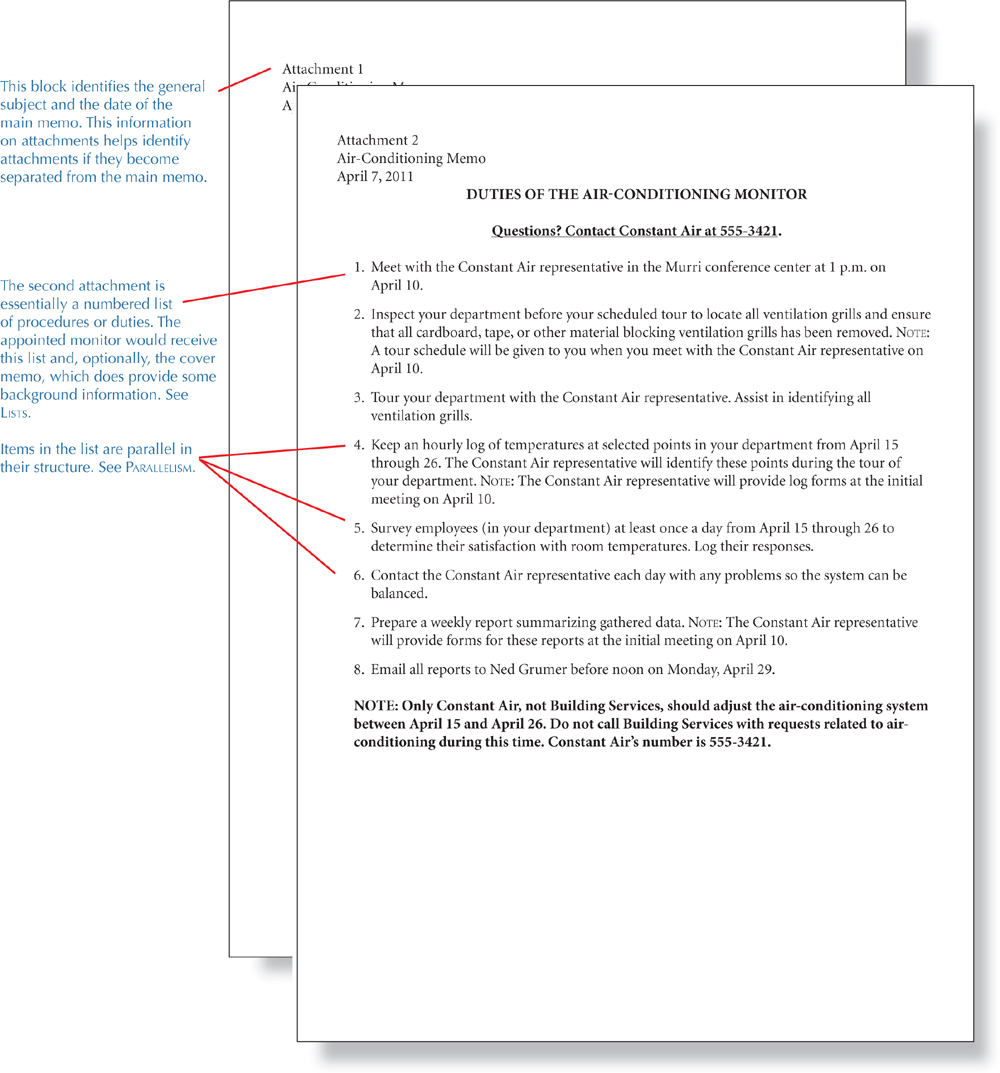
Attachments can be mysterious to recipients. That’s why you should identify on the attachment the original email it was attached to. Also, if recipients of a forwarded attachment receive the original email with it, the attachment itself doesn’t require a lot of set or explanation.
Technical Memo: With a Recommendation
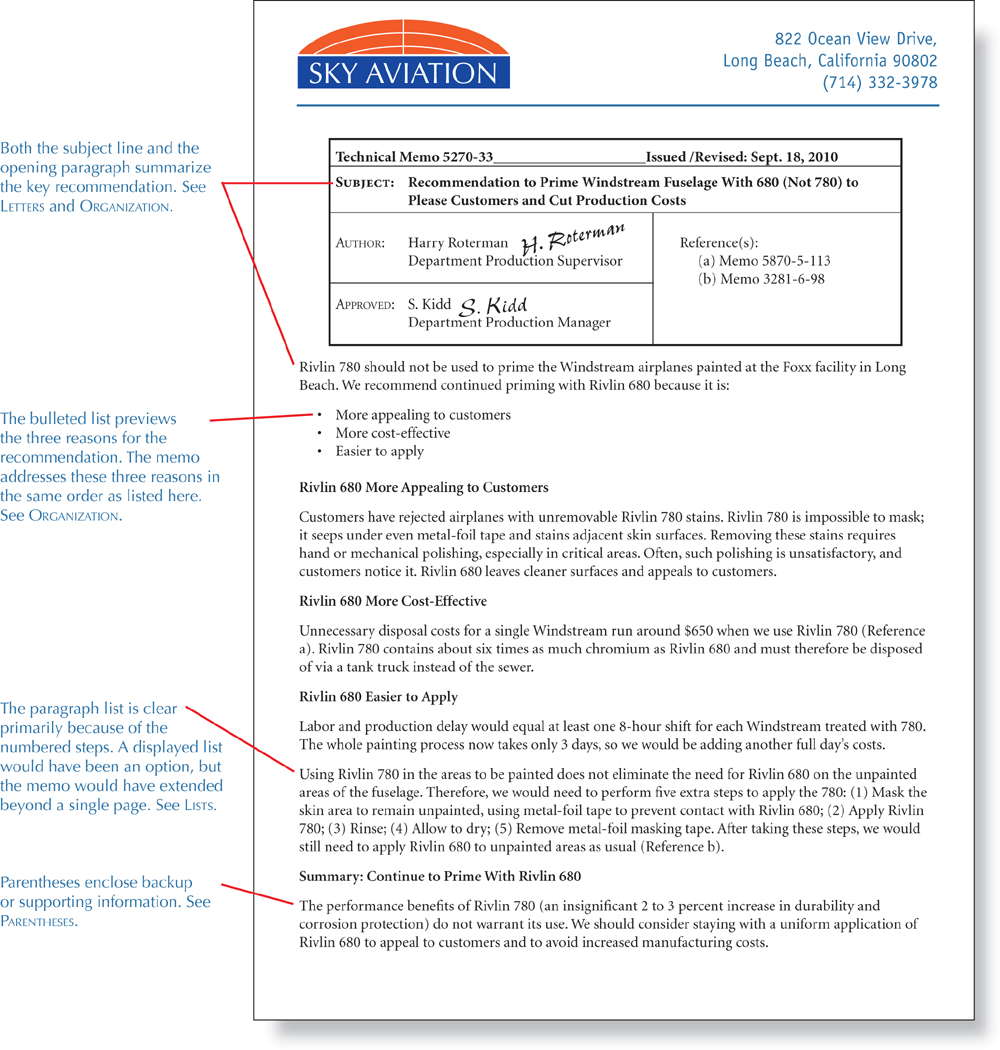
Technical memos are valuable internal communications because they capture key decisions within the design and engineering processes. As in the above example, the memo includes, as attachments or merely as references, other memos or reports. Referencing allows this memo to come to the point.
The memo follows the four-box letter organization. Box 1 (paragraph 1) opens with a request or a statement of purpose. Box 2 (paragraph 1, second sentence) summarizes or lists the points to be covered. Box 3 (the remaining paragraphs, except for the final one) expands on the points listed in box 2. Box 4 (the final subheading and paragraph) closes with a review of the content and a final request for action. See ORGANIZATION.
Recommendation Memo
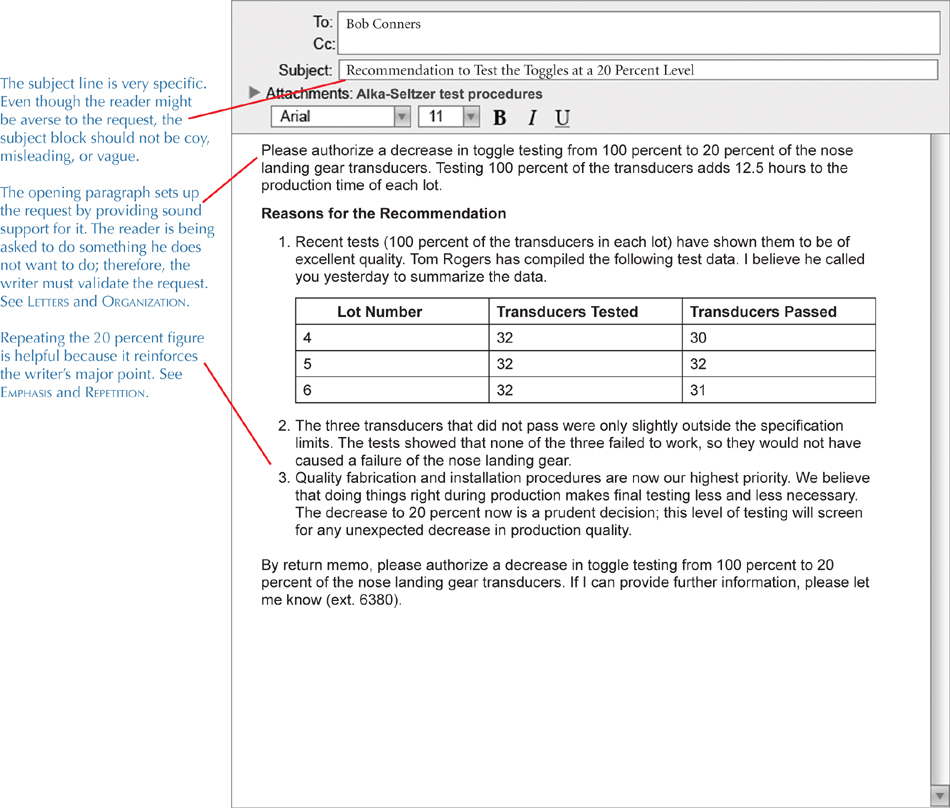
Whenever possible, writers should open their memos by clearly stating their request.
In this case, Bob Conners has been adamant about 100 percent toggle testing, so the sender knows that he or she must follow the request immediately with solid evidence to support it. An optional approach would be for the sender to delay the request until later in the memo. We do not recommend this option. See MEMOS, LETTERS, and ORGANIZATION.
Status Report Memo: With an Outcome Orientation

The report focuses on outcomes and action. It includes both accomplishments and problems so the reader has a complete picture and can help as needed. The format clearly identifies the main points and allows the reader to scan the document.
Safety Memo: With a Mild Reprimand
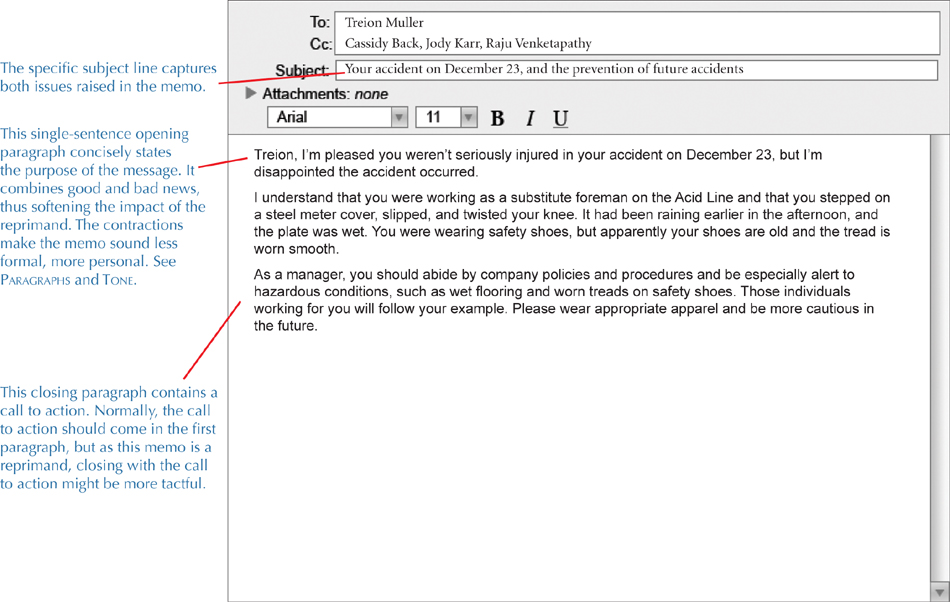
Personnel memos (or letters) are often hard to write, especially as in this case, when the memo contains even a mild reprimand. A proper tone is essential. As in this example, tone comes from several things: (1) positive information, as in the opening sentence; (2) a personal voice, using the addressee’s name, pronouns, and contractions in the opening; and (3) a firm but courteous closing, with reasonable and honest requests for improvements and with the use of please. See PRONOUNS, MEMOS, and TONE.
Personnel Memo: With Suggested Prodedures

Personnel notices often require a light touch. Employees rightly object to personnel notices that are too serious, impersonal, or even critical in tone (and content). Managers and supervisors sometimes have to send reminders and requests that are potentially negative (as this notice could be). The lighter tone helps writers convey negative information in a manner that readers will not find objectionable. See LETTERS, MEMOS, and TONE.
Response Memo: With Instructions
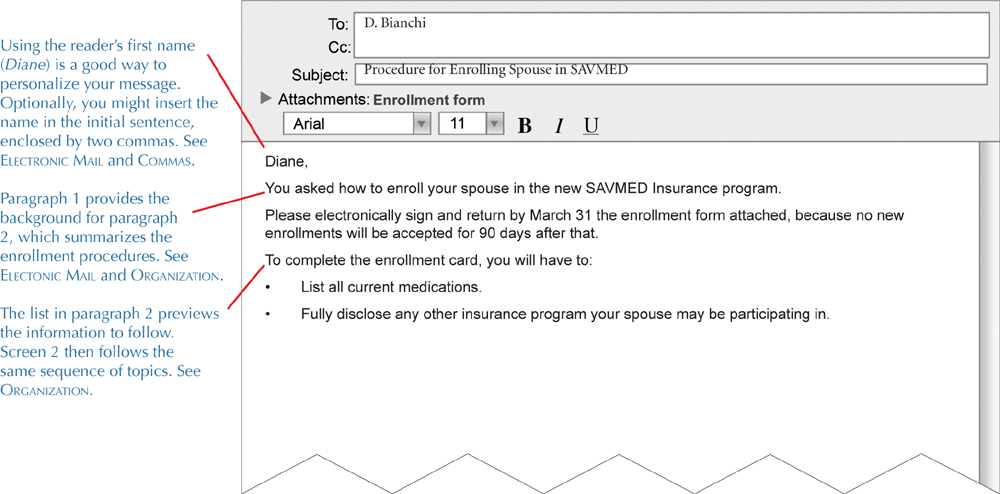
Electronic mail (email) needs to be just as clear and as well written as printed documents. Often you might be tempted to dash off an email message without taking time to check it for accuracy or completeness. If you don’t check your message, you may find yourself sending a follow-up email to cover missing facts or information. See ELECTRONIC MAIL.
Transmittal Memo: For Attachments
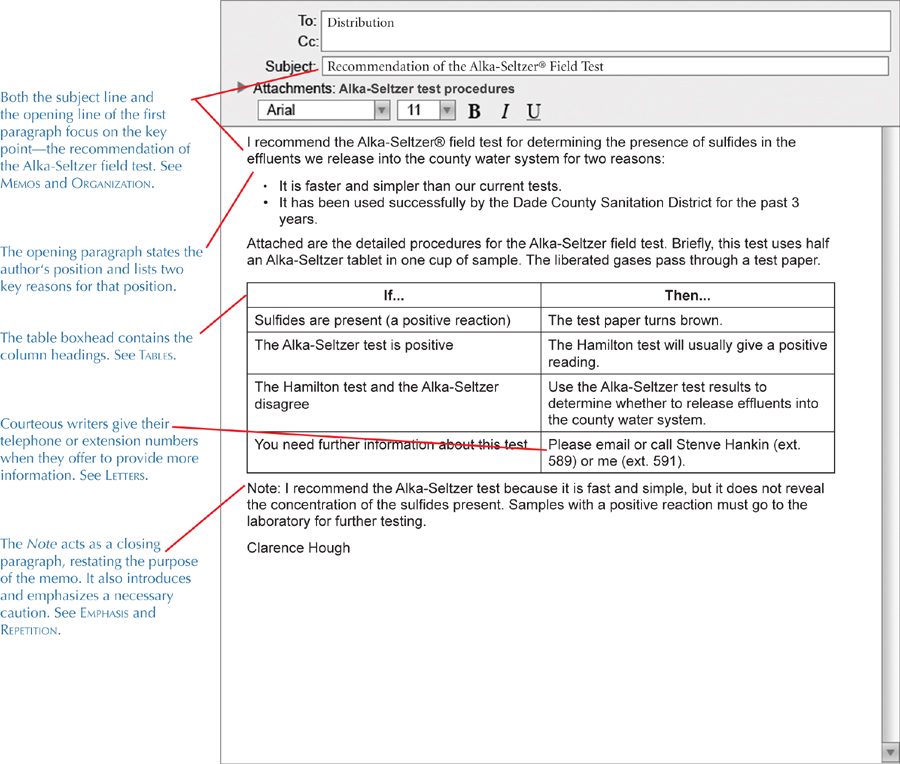
A transmittal memo accompanies another document, such as a report or a procedure, and briefly explains the purpose and content of the attachment.
Resume: Problem-Solution Format
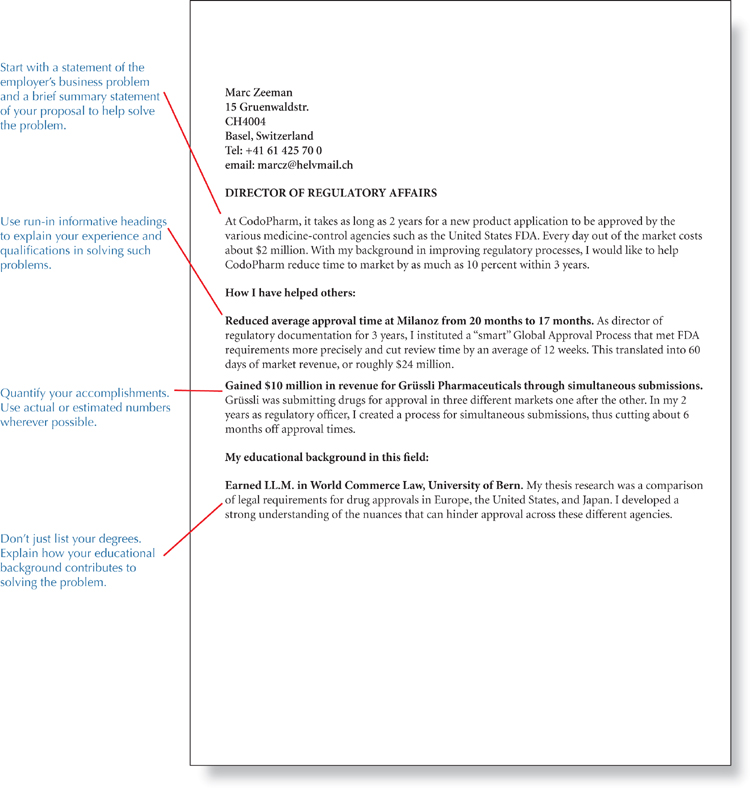
Most resumes simply list jobs and educational attainments in chronological order. This approach to resume writing is less effective than a “problem-solution” approach, in which you address real problems or opportunities your prospective employer faces. A problem-solution resume will distinguish you immediately from other applicants. Do careful research about the employer before writing a resume like this.
Resume layouts vary, but yours should be readable and uncluttered. Avoid irrelevant personal information like age, marital status, or outside interests.
Resume: Performance Format
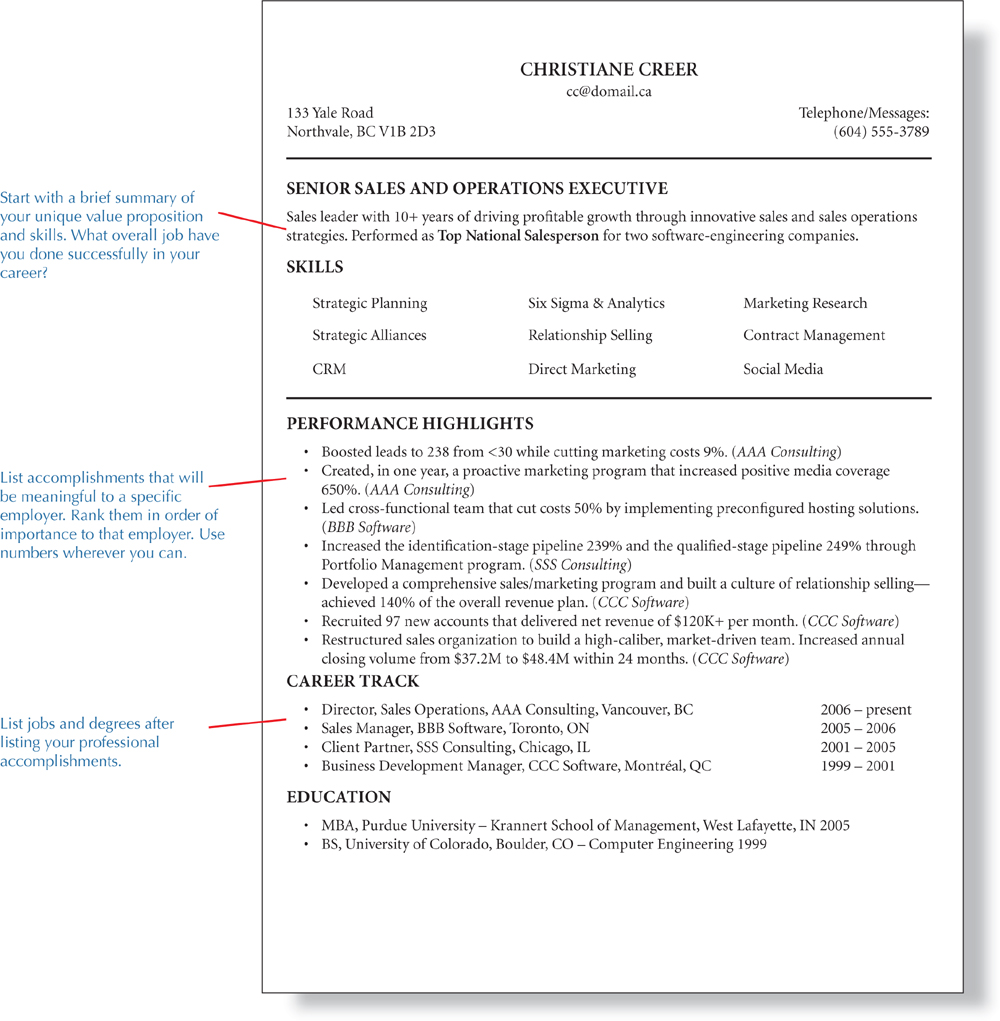
A resume need not follow the traditional format of listing only jobs and educational attainments. Instead, resumes can be designed to emphasize qualifications, as the above resume does in its list of accomplishments. The best resume directly addresses the needs of the employer identified in research. For example, this resume appeals to a particular employer’s need for someone who combines revenue-producing capabilities with creativity.
Resume Cover Letter
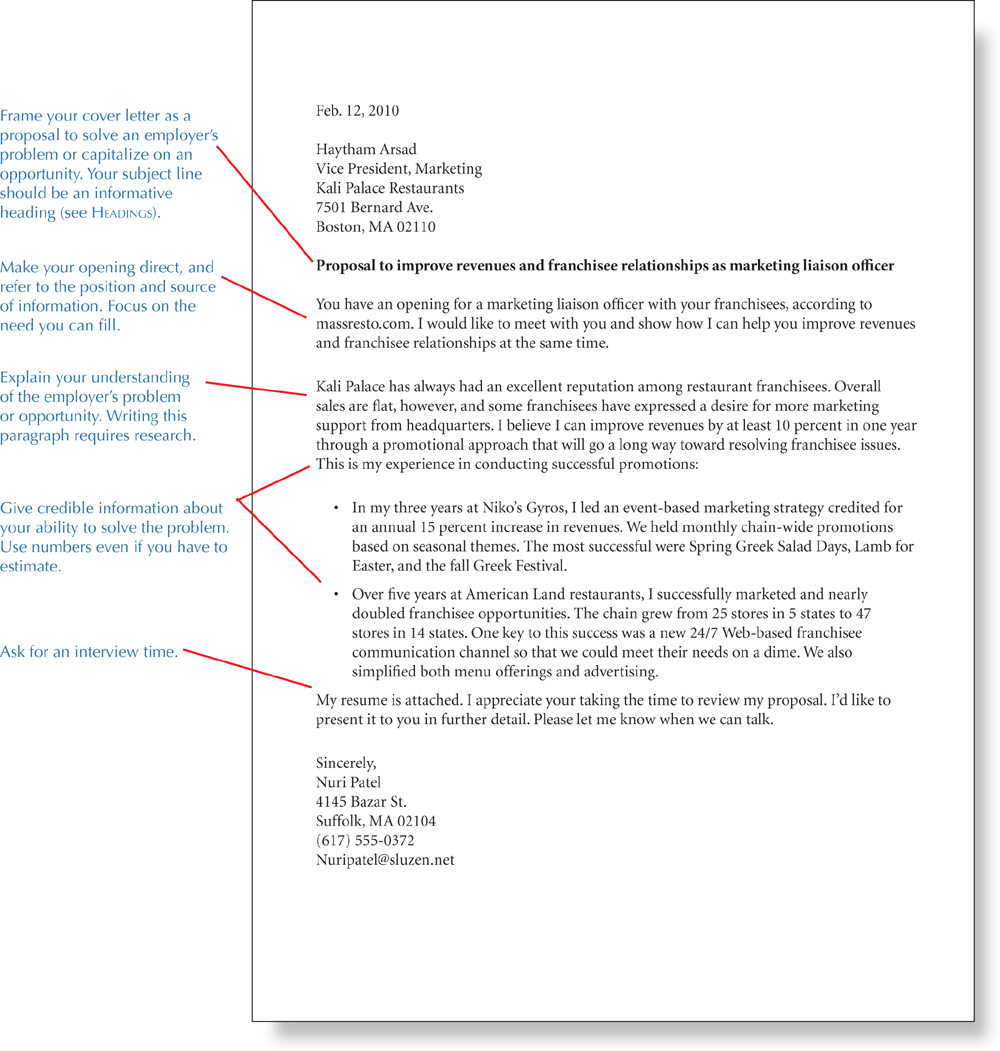
The cover letter is more than a formality—it is your chance to show that you are a solution and not just another job-seeker. The purpose of the cover letter is to sell the reader on granting you an interview.
Many employers are more interested in your cover letter than in your resume because it tells them why you’re applying and gives insight into your personality. Thus, you should use the cover letter as an opportunity to start a conversation with the employer about the value you can bring.
In your cover letter, you can expand or amplify important information that can only be reported in an abbreviated way in your resume. Be direct about your qualifications, but focus on employer needs and opportunities.
Always follow any interviews with a thank-you note.
Minutes
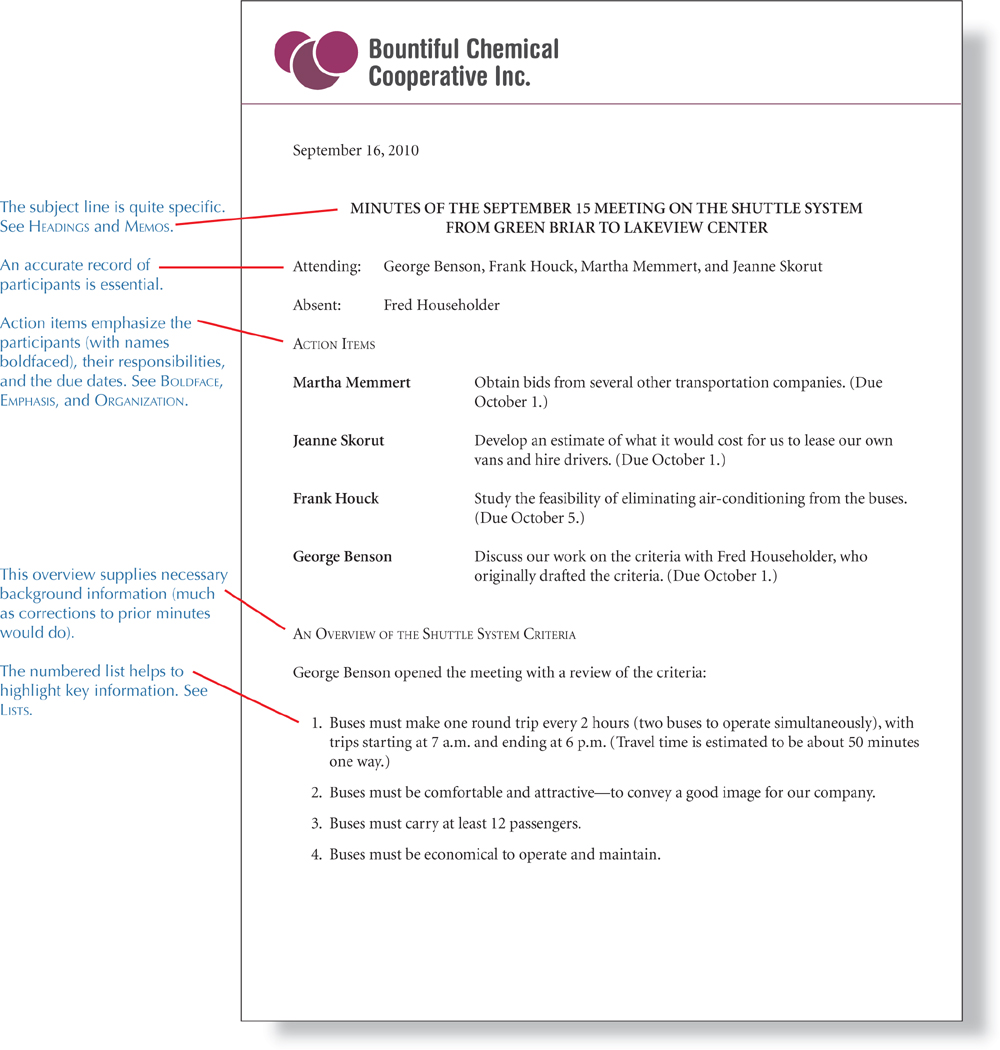
Minutes should highlight (1) actions during the meeting and (2) actions needed in the future (usually before the next meeting). Minutes should not attempt to capture everything that was discussed, and they deliberately do not record the meeting in strict chronological order. See ORGANIZATION and MEETINGS MANAGEMENT.
The headings, lists, short paragraphs, and brief sentences all contribute to the overall readability. See EMPHASIS.
Some repetition is inevitable at times, especially if the meeting is long and the issues complex. See REPETITION.
Job Description

Clear and thorough job descriptions should become the basis for internal job postings and external job advertisements. Keep job descriptions up to date and use them as a tool in shared expectation reviews or performance reviews between employees and supervisors.
Companies have quite different policies about how and when to do performance reviews (often called shared expectation reviews). Because policies are so different, we do not provide any written examples of a performance review.
Executive Summary: For a Proposal (Financial Services)
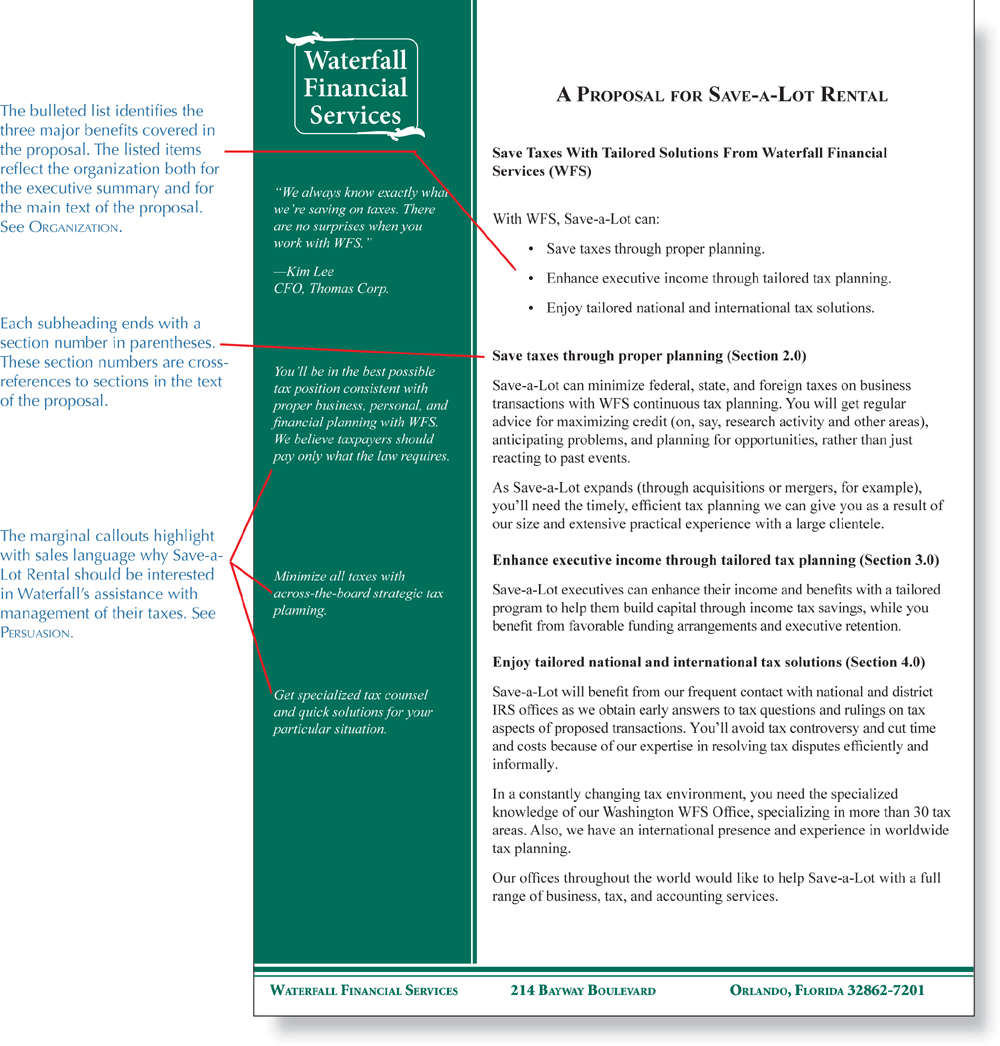
Effective proposals usually include a well-written executive summary. Usually, as in this example, the executive summary highlights key benefits to the customer. Also, the summary introduces with cross-references key content in the main text of the proposal.
The many references to Save-a-Lot help tailor the proposal to Save-a-Lot readers, even though much of the text would be generic and usable for any client.
A brief, highly readable executive summary has become the standard opening for most proposals. An executive summary combines persuasive sales information with a preview of the contents of the proposal. Often, as in the above example, each subhead in the executive summary parallels a section in the proposal.
Executive Summary: For a Proposal (Training)
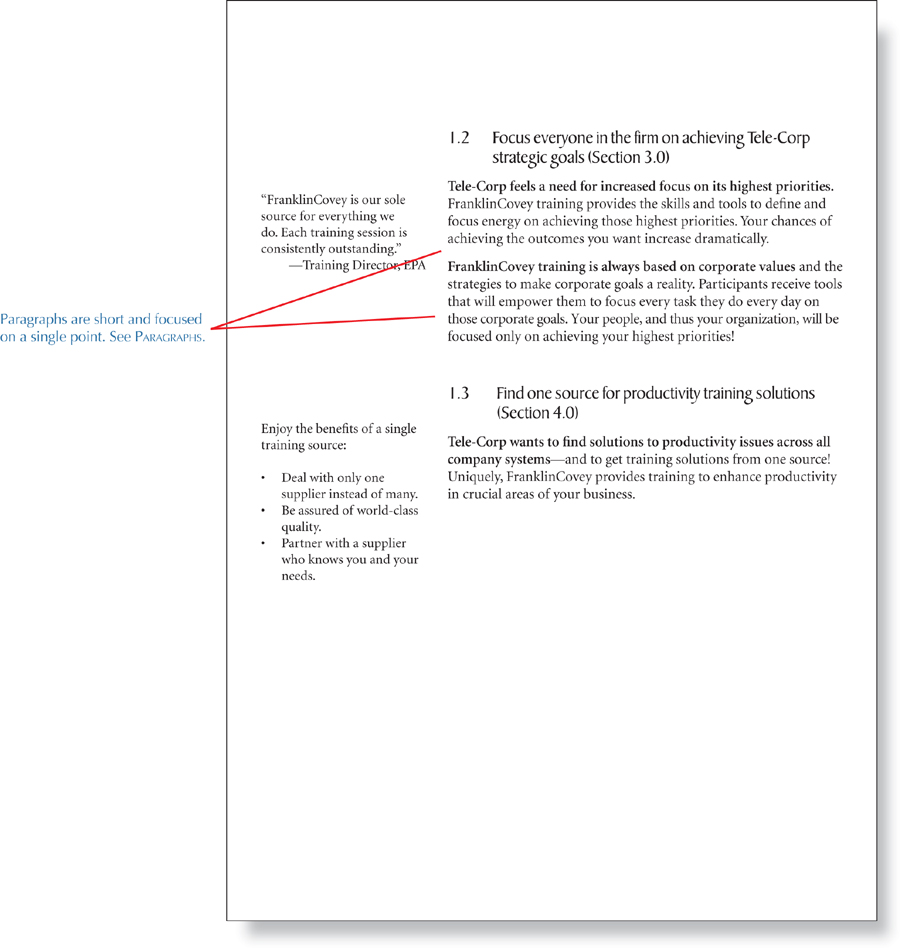
Executive Summary: For an Audit
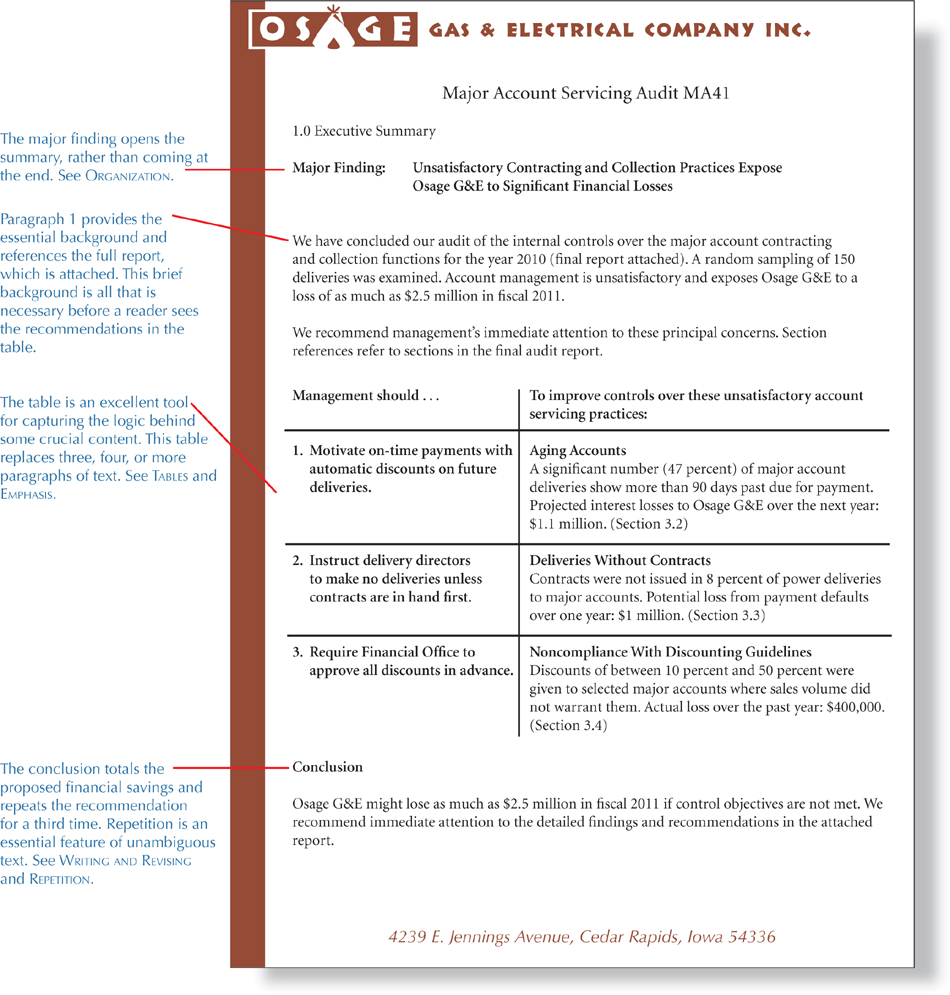
This executive summary opens with the major finding and the supporting recommendations. We recommend using this organization instead of the more traditional organization. Traditional audit reports often mirror the audit process, which begins with the collection of data, interviews with key employees, the collection of more data, and finally some interpretations. Following that sequence, the traditional report would present the audit findings on page 20, page 30, or later. See ORGANIZATION and SUMMARIES.
This initial page contains some cross-references to later sections of the audit report. These references would help readers to search and find information more efficiently. (We have not included these additional pages from the audit report.)
Marketing Fact Sheet
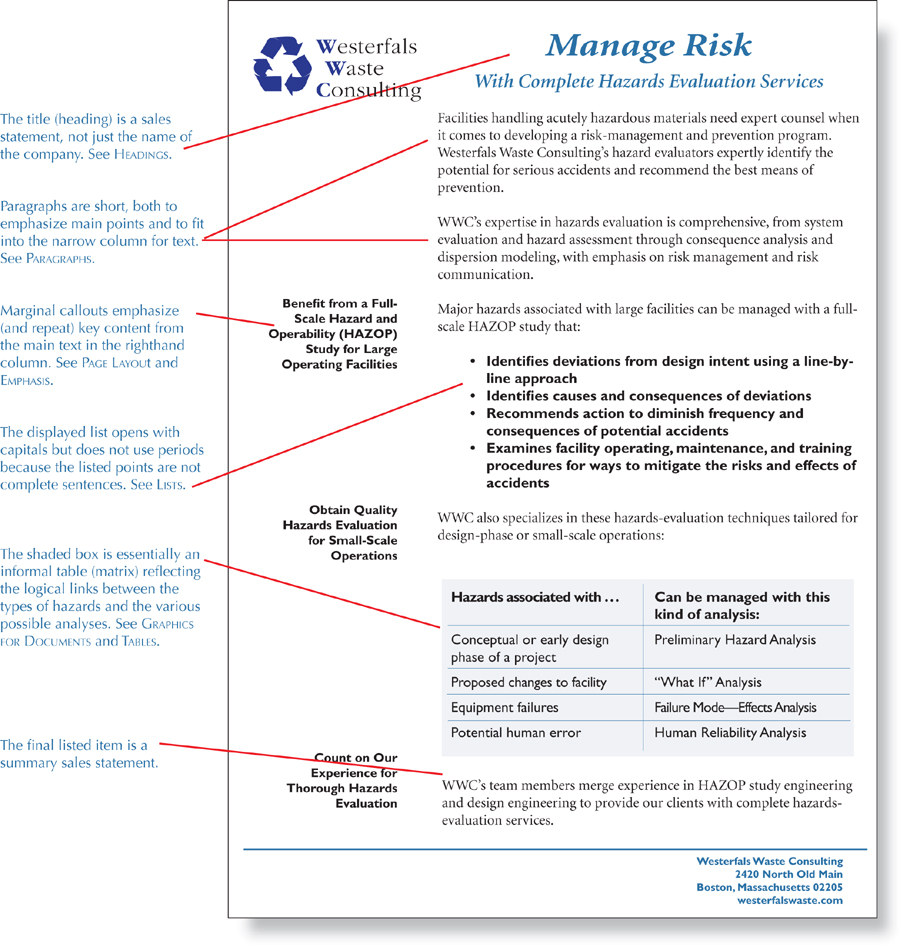
This marketing fact sheet deliberately uses text. Other versions might be more graphic, with only a few bulleted headline statements. This fact sheet could be sent to prospective clients as an attachment to a sales letter.
The format is designed to be open and inviting, and the text focuses on the two key benefits a client would gain from using Westerfals for waste-management problems.
Mission Statement
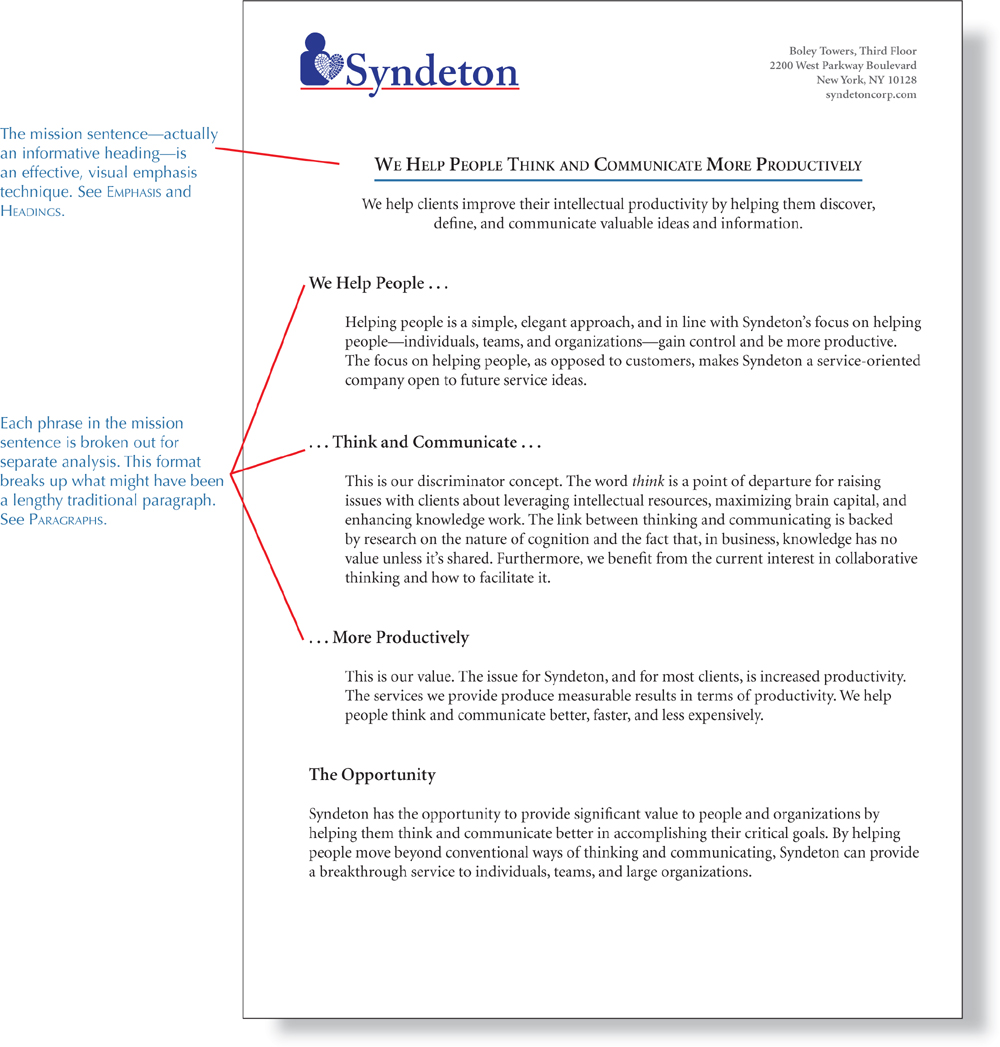
Mission statements are increasingly important because businesses and other organizations need a clear view of their core values and goals. Otherwise, employees will often waste time and money on peripheral tasks.
Successful mission statements must be brief (only one or two pages, at most). They should also be organized around a slogan or key sentence, as in the mission sentence that is the heading above.
Page 2 of this mission statement shifts to four success stories from actual clients. This shift to marketing or sales information is especially appropriate if the mission statement will be circulated to customers.
Procedure: For a Business Process
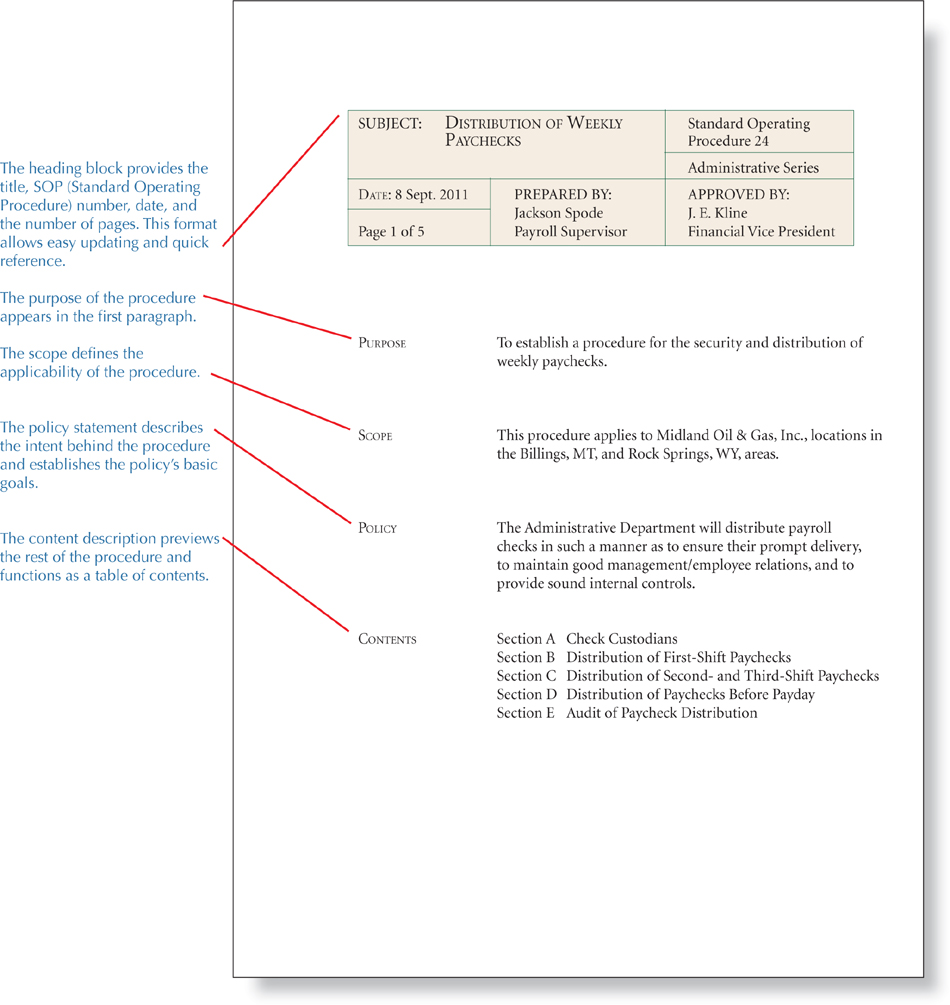
Procedures should be as schematic as possible, with headings, lists, and imperative statements. These format techniques enhance readability and allow readers to find their particular responsibilities and actions.
Inevitably, procedures must be updated, so the numbering system, date of creation, and any revision date need to appear on each page.
The most common problem with procedures is the passive voice. Writers list actions passively, and readers often don’t know who is supposed to do what. A procedure that says “checks must be examined before delivery” does not indicate who is supposed to do the examining. Therefore, all steps in procedures must identify not only the action but also the person or the department responsible. See ACTIVE/PASSIVE.
Each step in the procedure opens with the person or department responsible for the step. Next comes the action associated with the step. Note that the action is stated in imperative sentences. See SENTENCES and ACTIVE/PASSIVE.
NOTE: This procedure would have several more pages. Because the other pages would add little to the model, we have omitted them.
Procedure: For a Technical Process
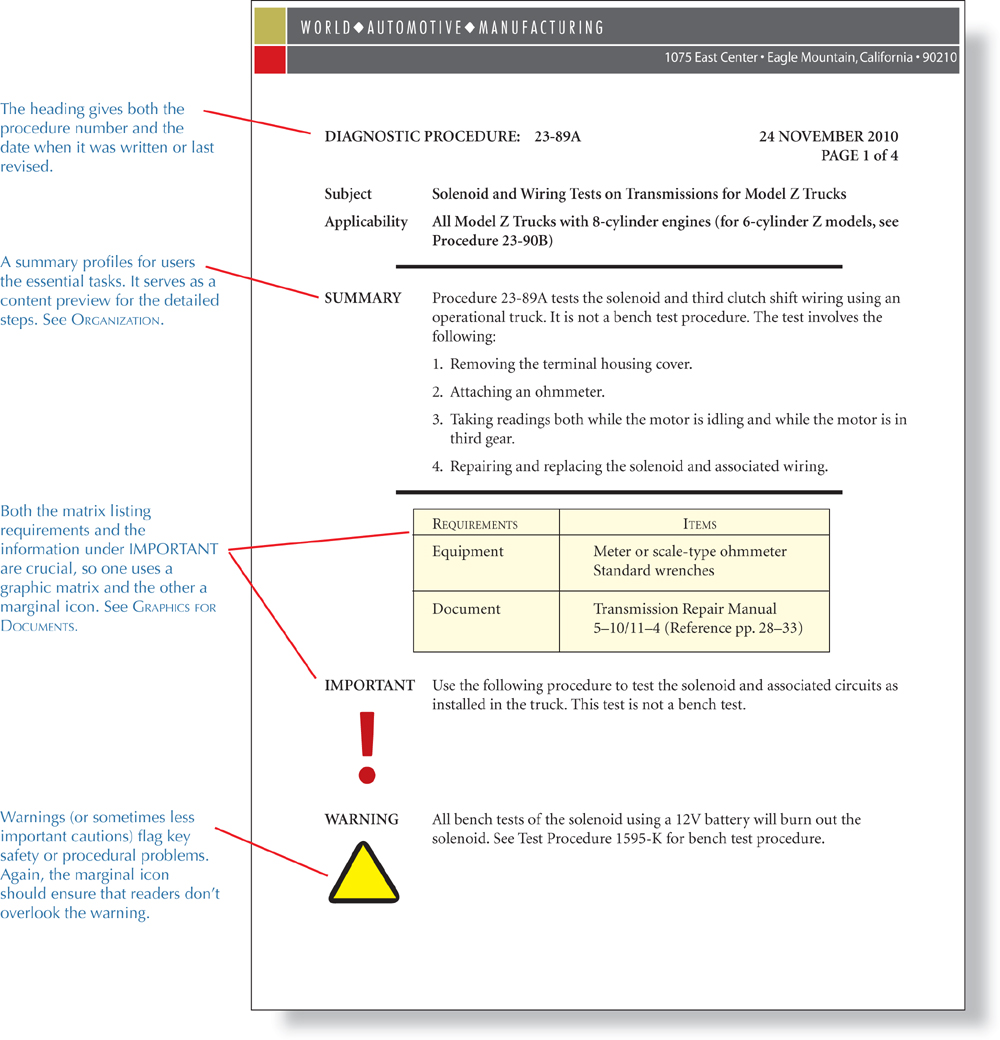
A technical procedure must be both accurate and very readable. If possible, it should be 100 percent unambiguous—that is, its graphics and its text should present steps that no reader can misinterpret. See WRITING AND REVISING.
For clarity, each step in the procedure reflects a single task, and the tasks are carefully sequenced. The numbering of the steps allows for easy referencing and recall if one or more need to be repeated. See LISTS and NUMBERING SYSTEMS.
Technical Report
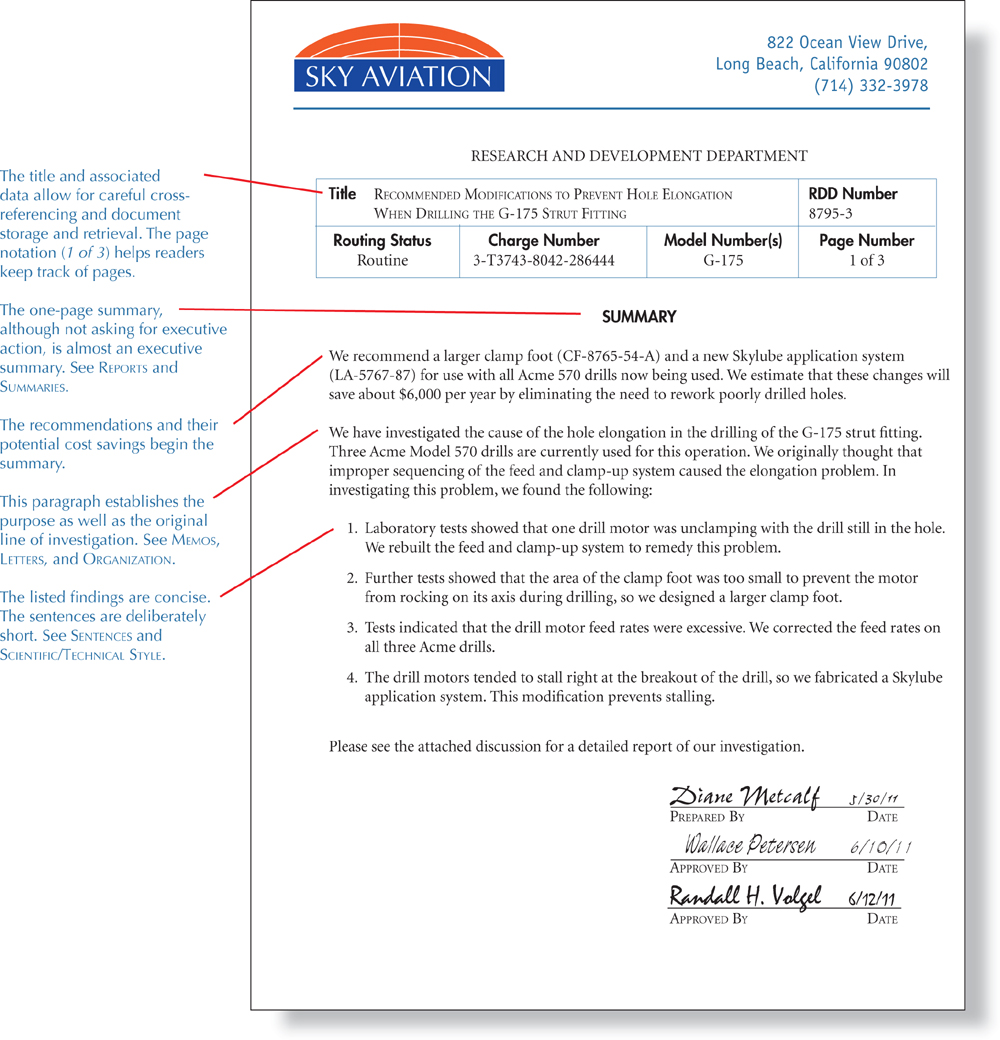
The summary (likely limited to one page) is a powerful technique for limiting documentation and for making technical reports more accessible. Many readers will not want or need to read more than the summary. If the summary contains the important details, these readers will be able to determine whether they need to read further. See REPORTS, SUMMARIES, and ORGANIZATION.
The body of the report follows a scientific format rather than a managerial format. Thus, the conclusions and recommendations appear at the end rather than at the beginning. In most cases, the sequence and specificity of the headings in the body are almost irrelevant. Most readers will not read carefully beyond the summary, and readers familiar with the report format will already understand the content and organization of ideas appearing in the body. See ORGANIZATION.
Web Page: With Informative Content
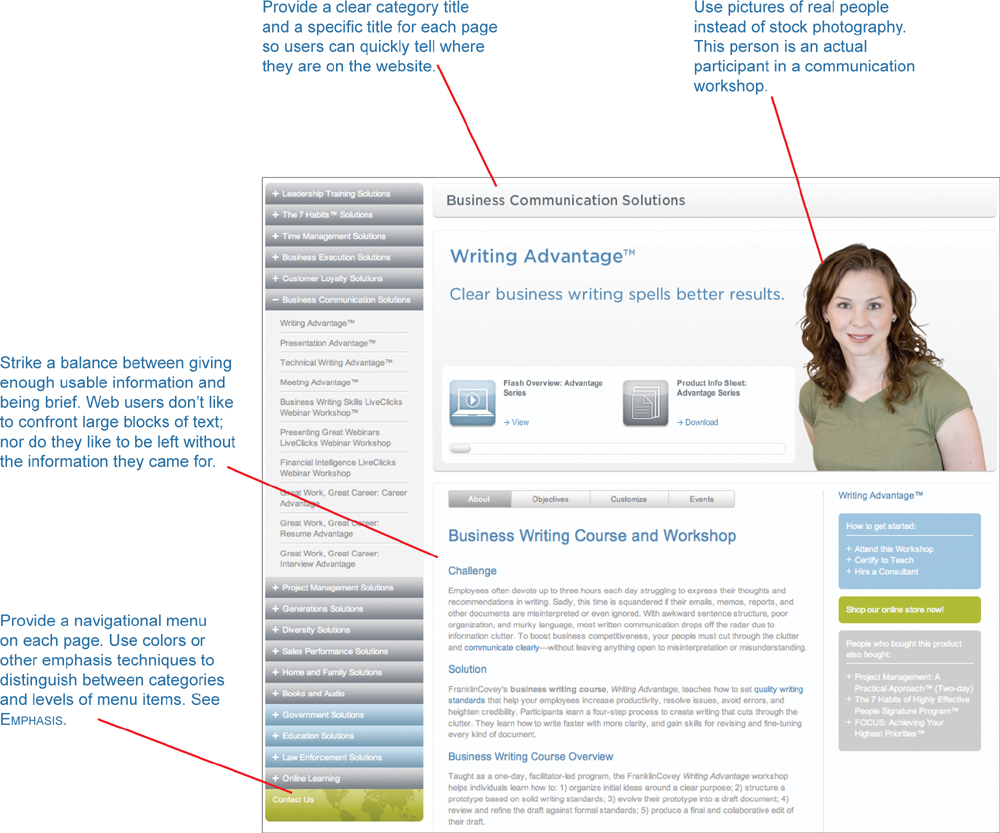
A business Web page serves the needs of customers, suppliers, and employees. Design the page the same way you would any customer-oriented document: make it easy to access the information the user wants. Most visitors to this page are interested in (1) the benefits and (2) the features of a service; so the “challenge-solution” structure works well for them.
Reading Internet pages is harder than reading print because screen resolution is only a fraction of that of a printed page. Therefore, design Web pages to be spacious as well as informative. Three columns of text are easier to read than one wide column.
